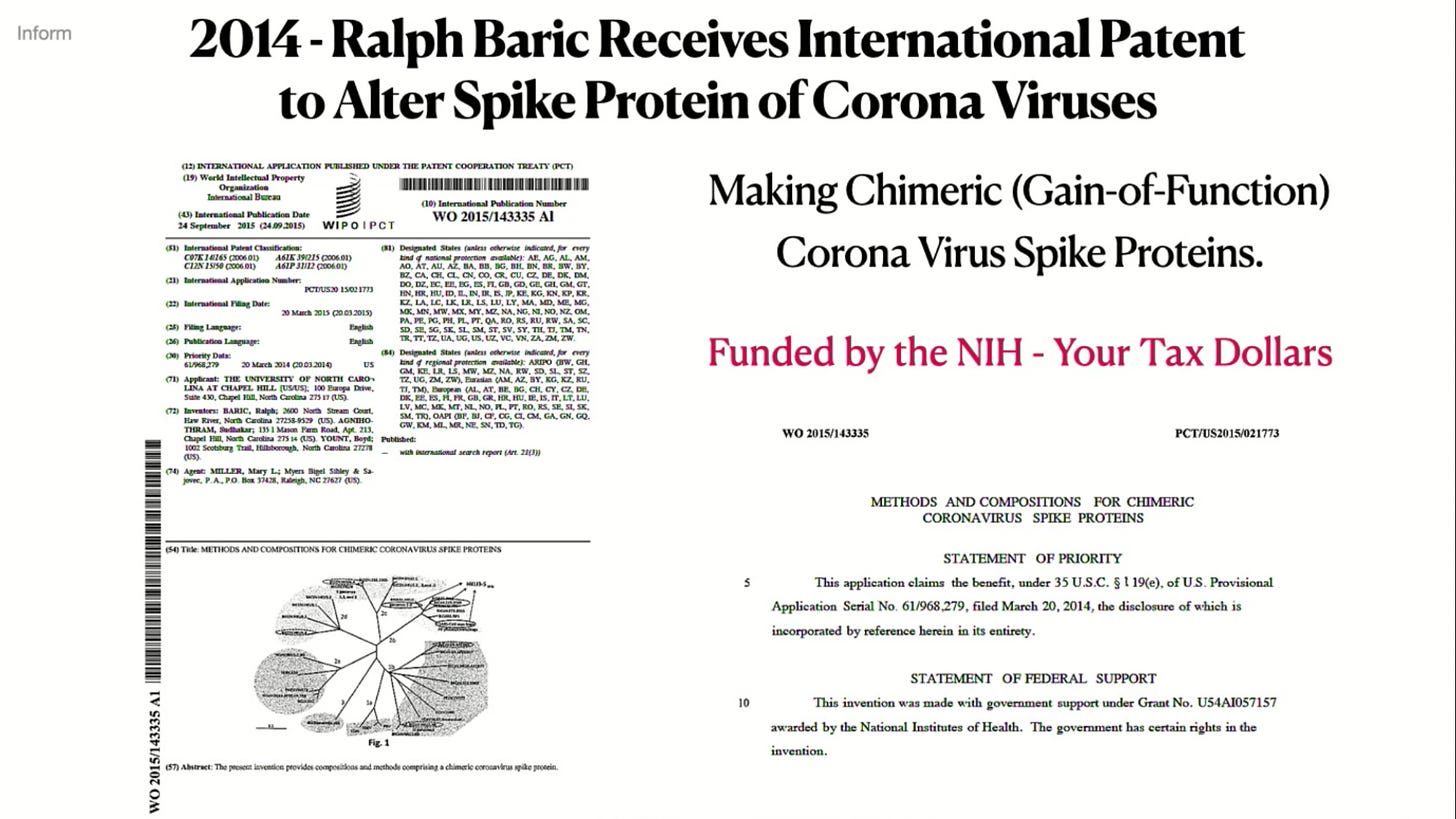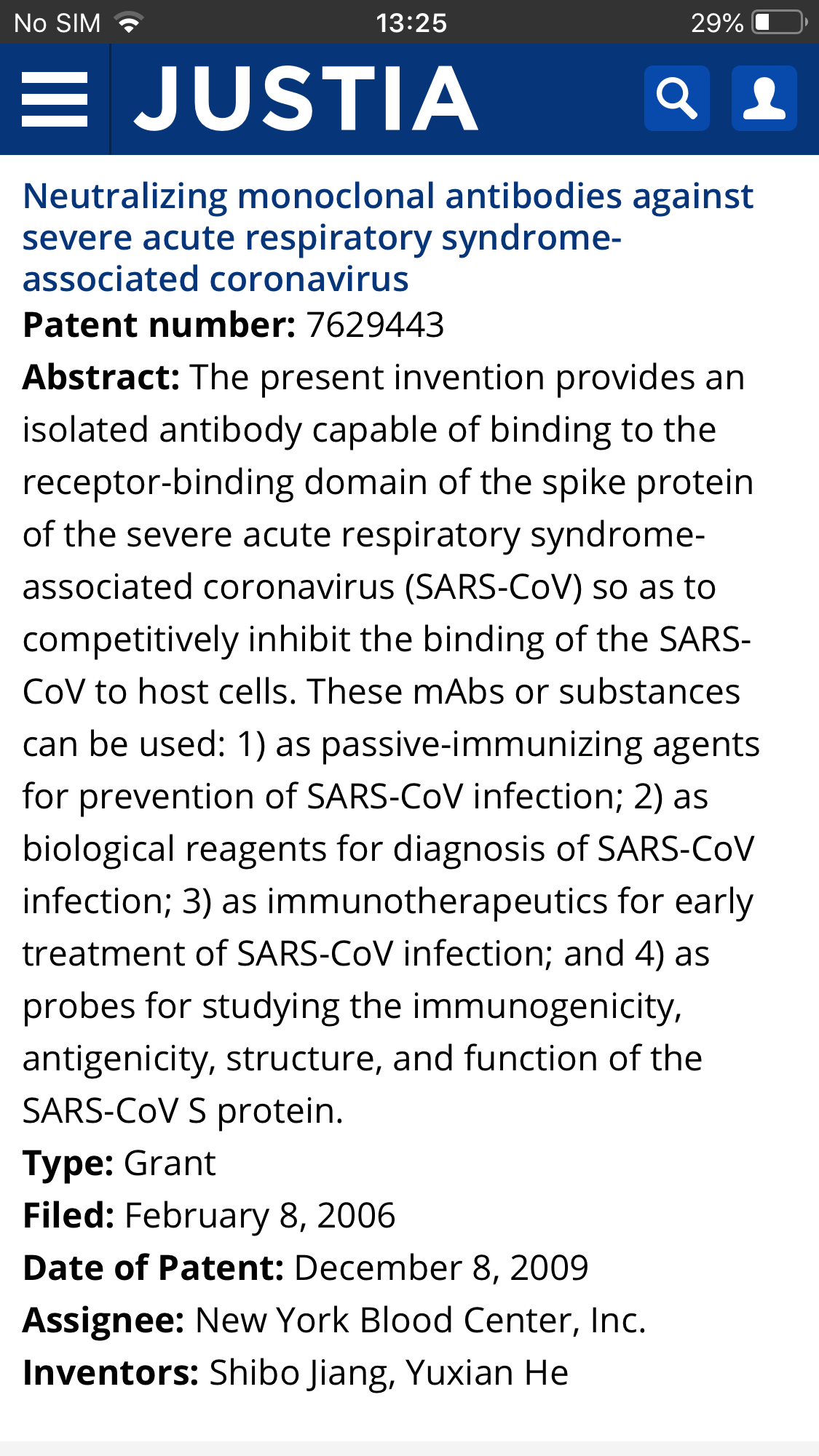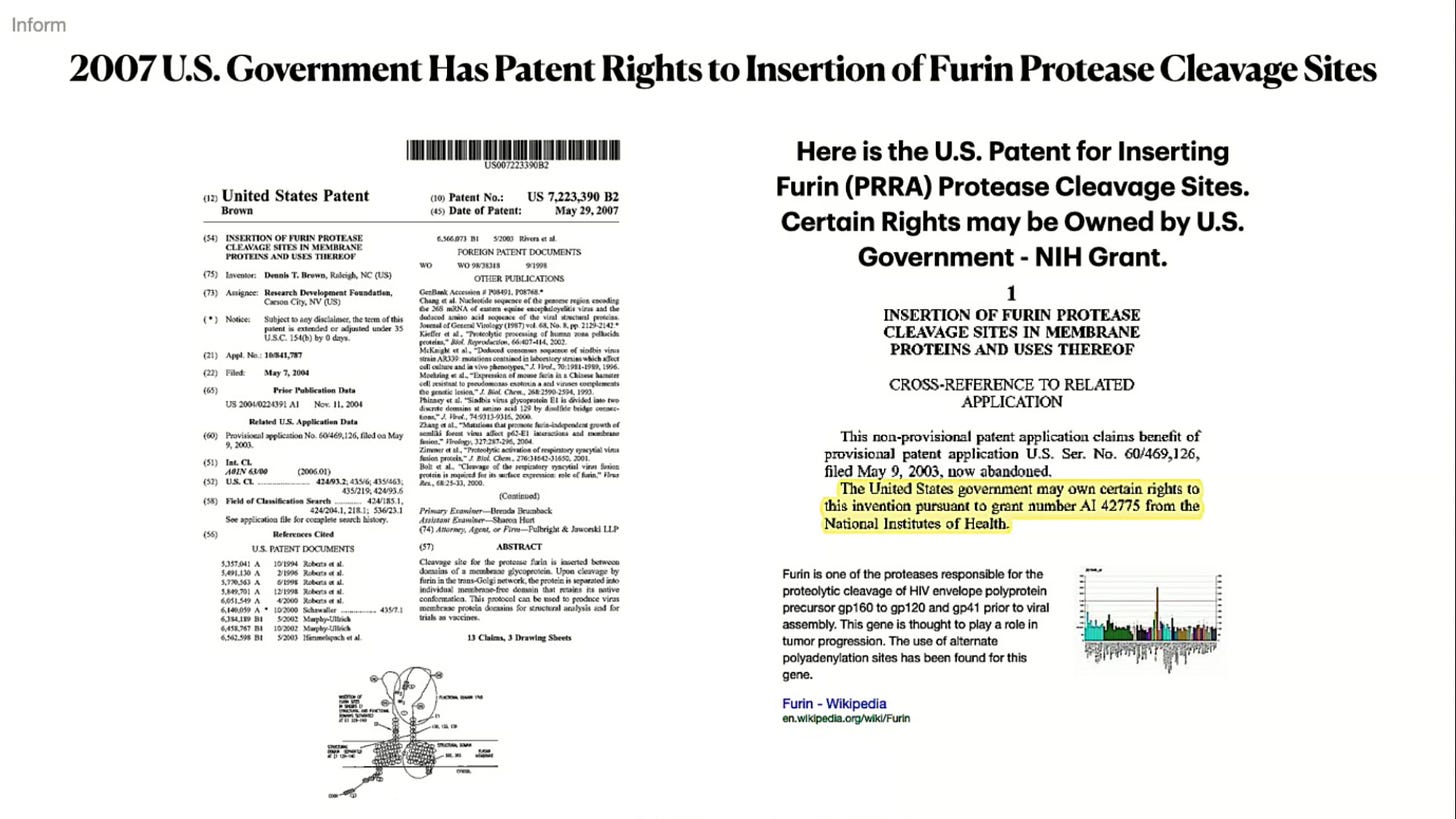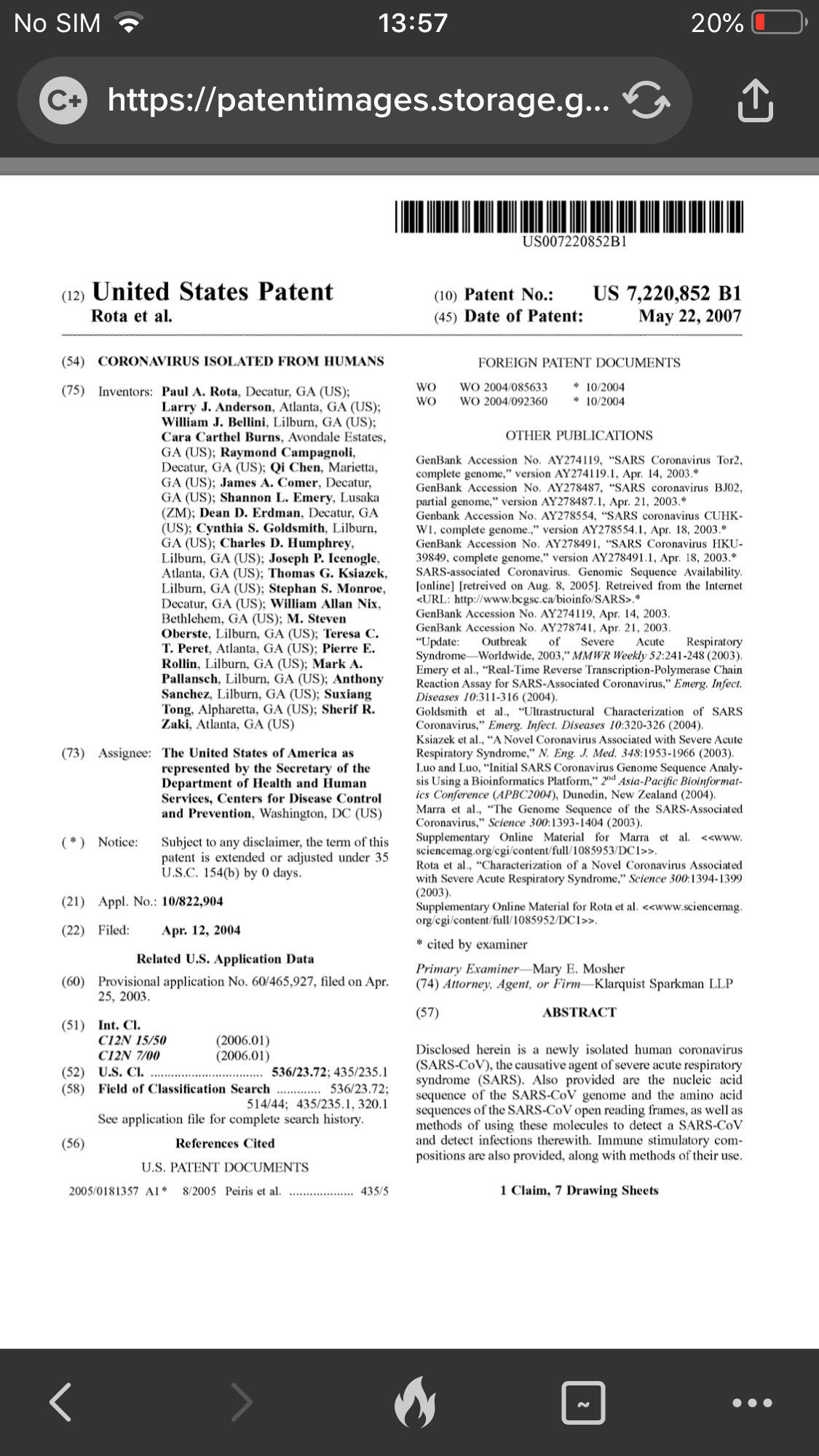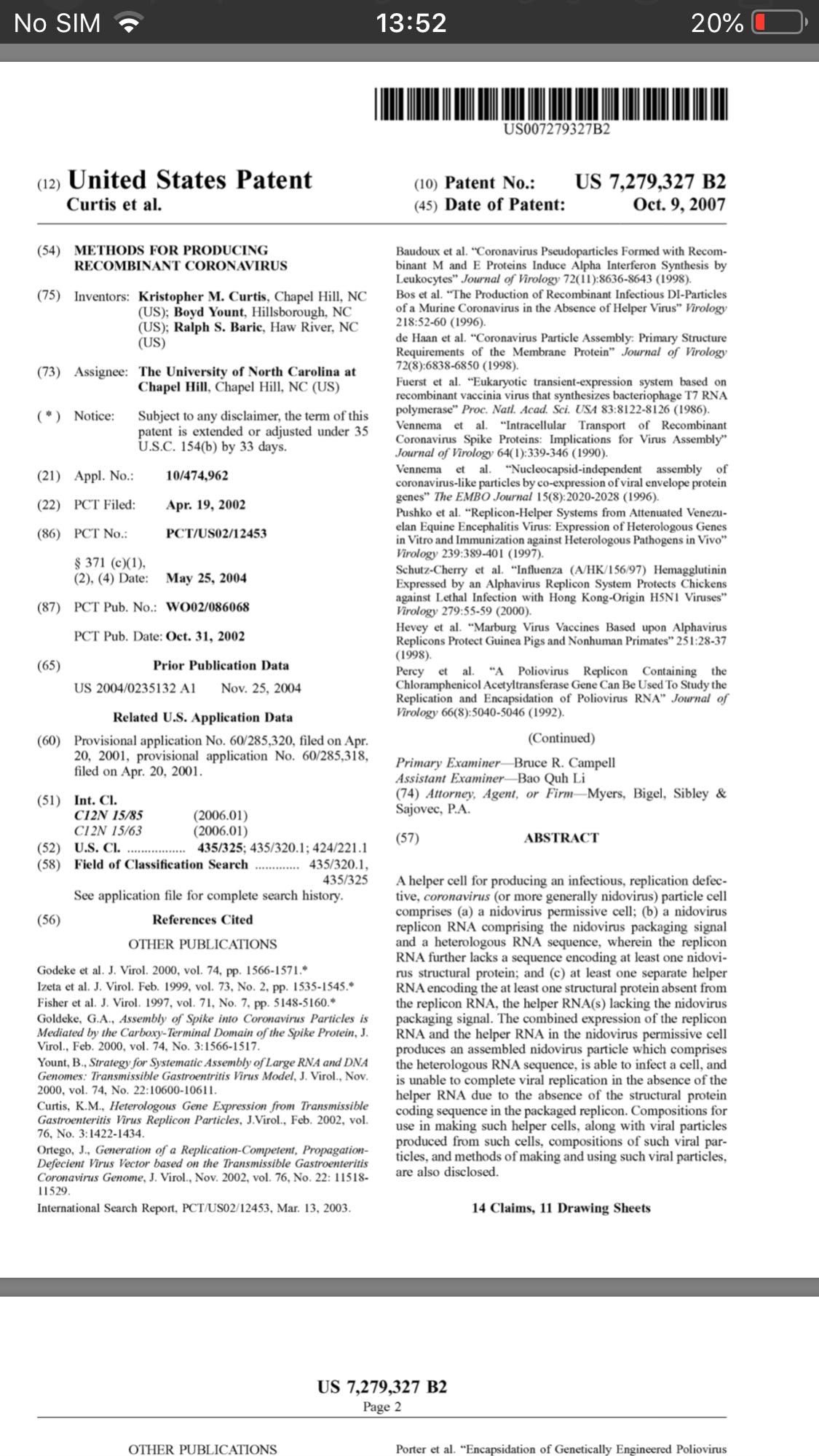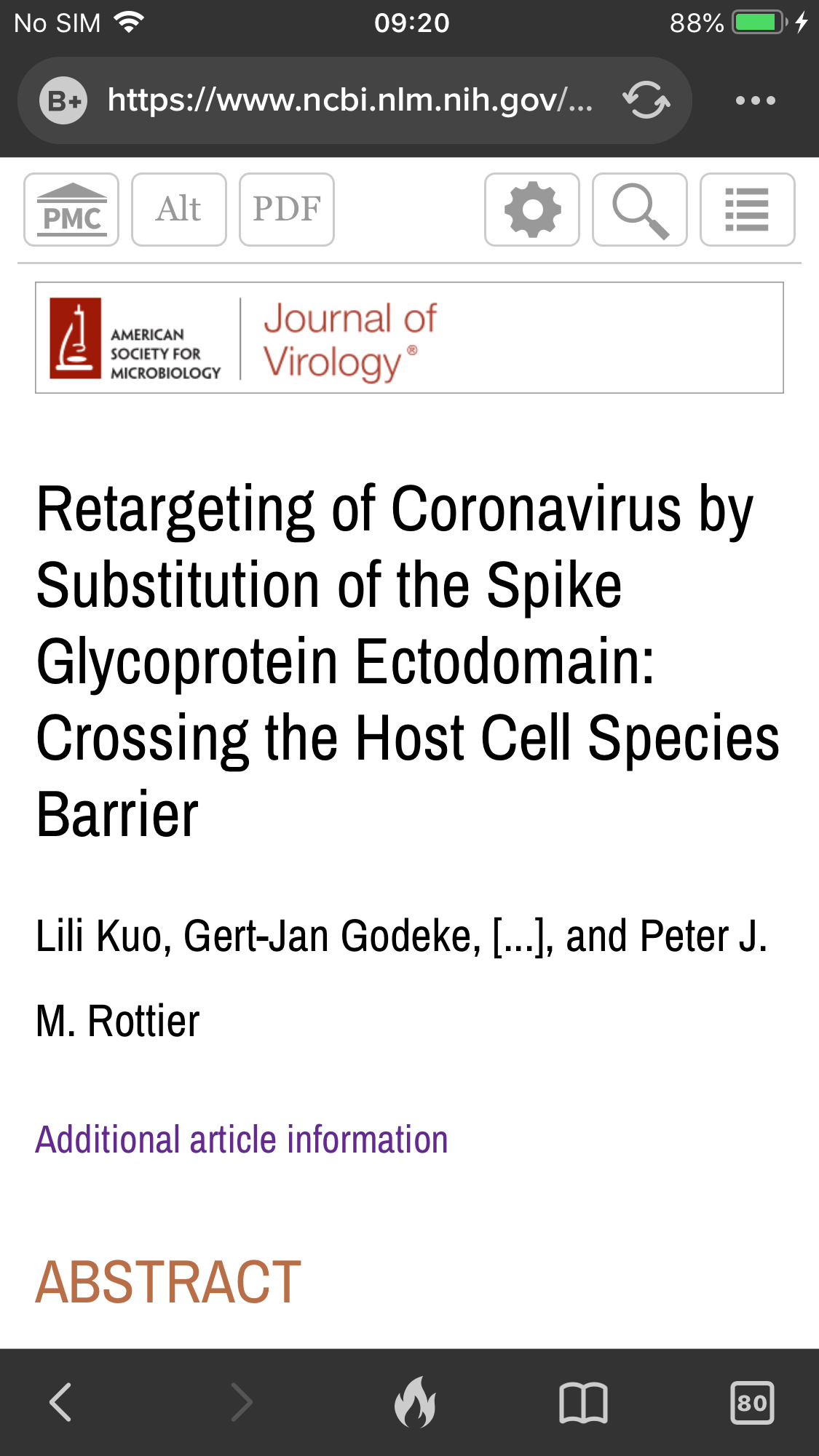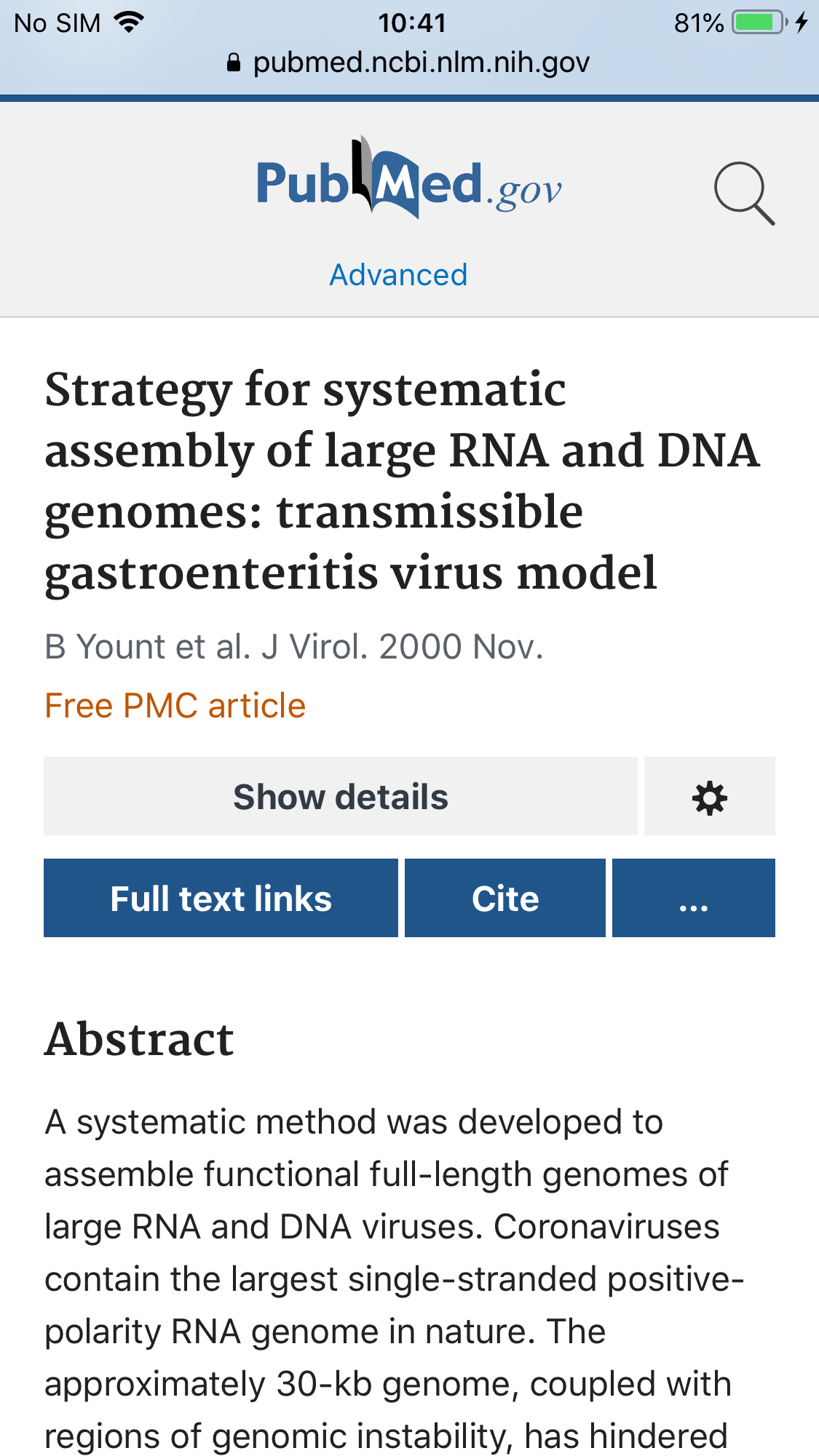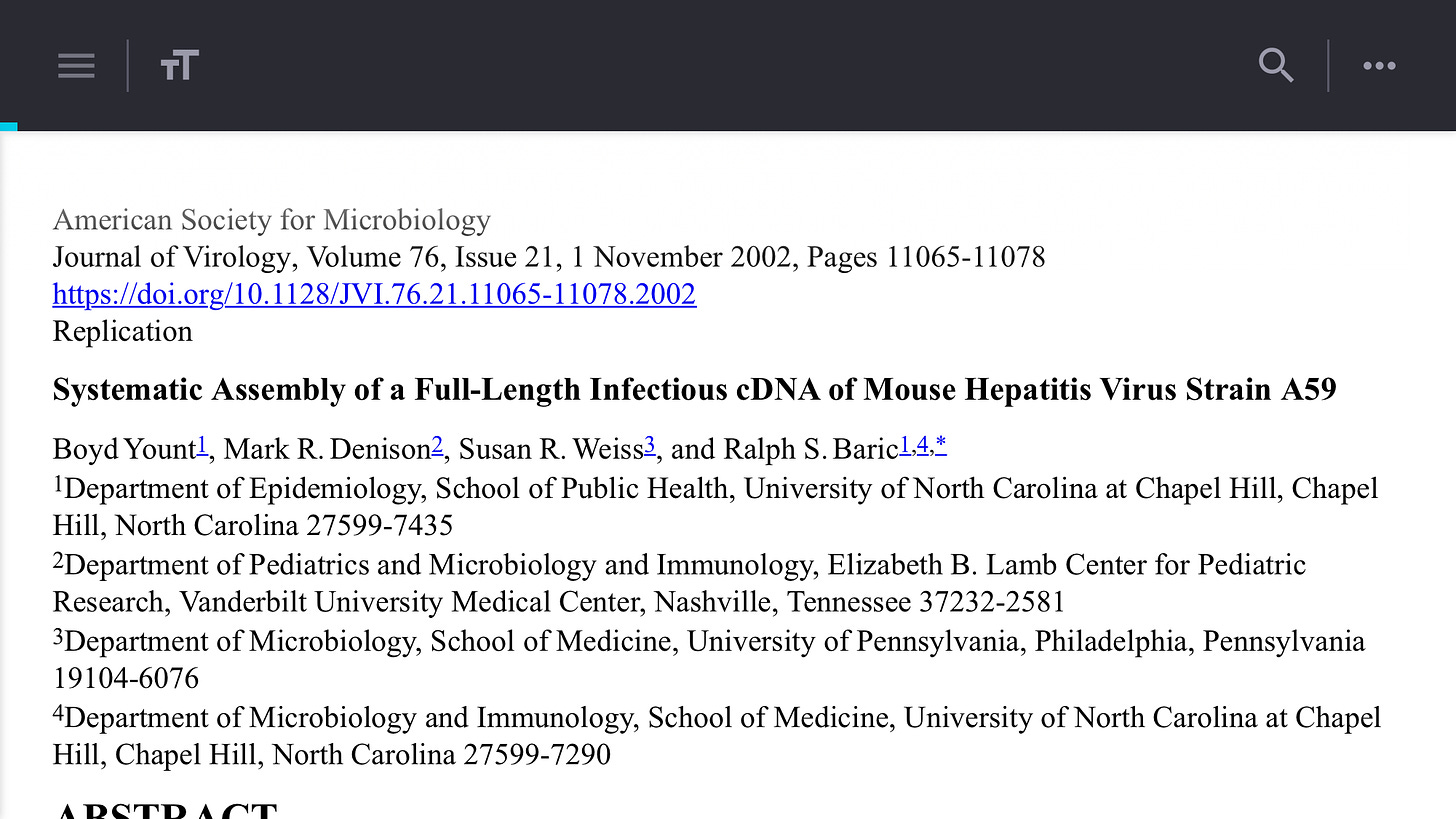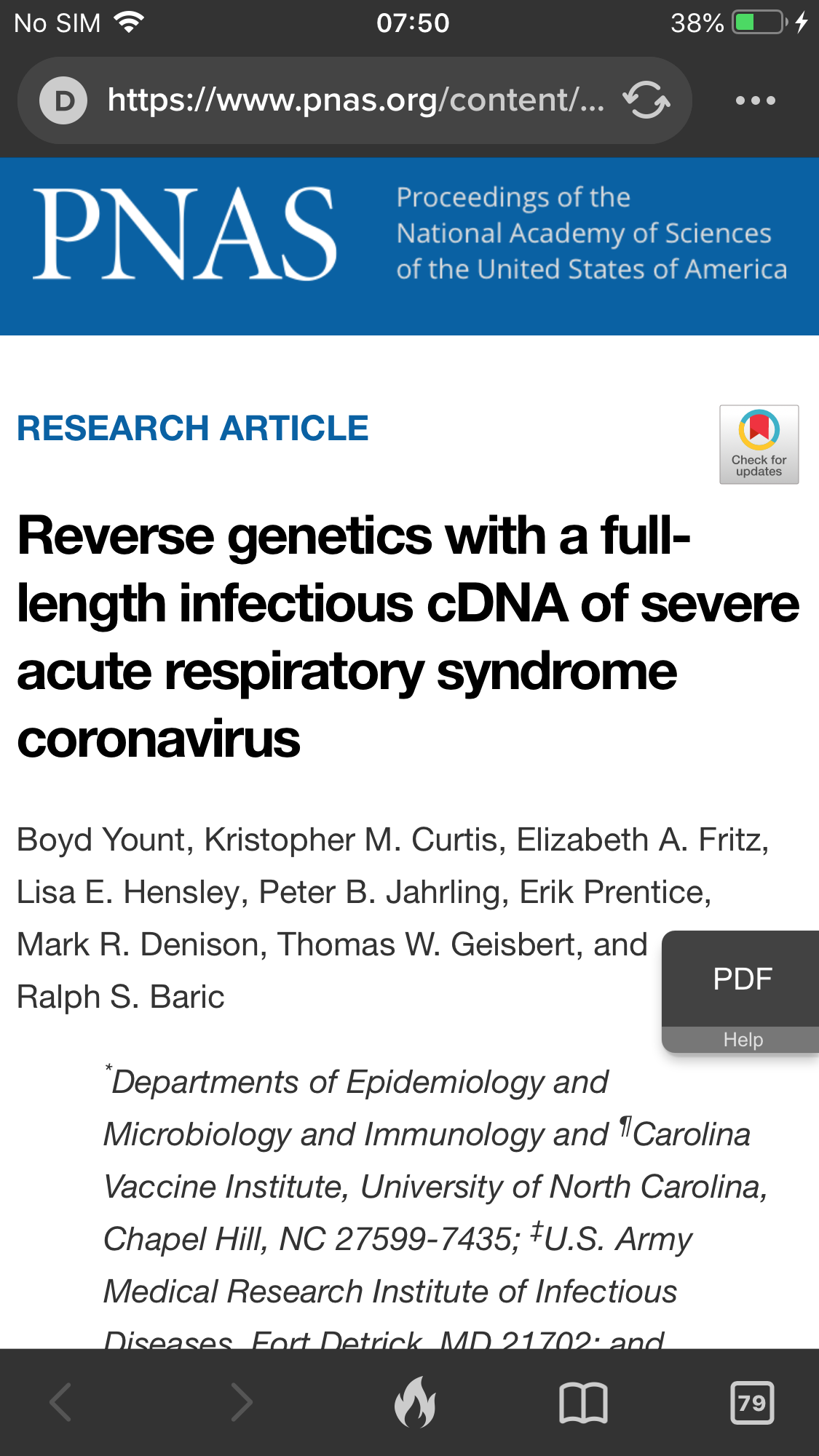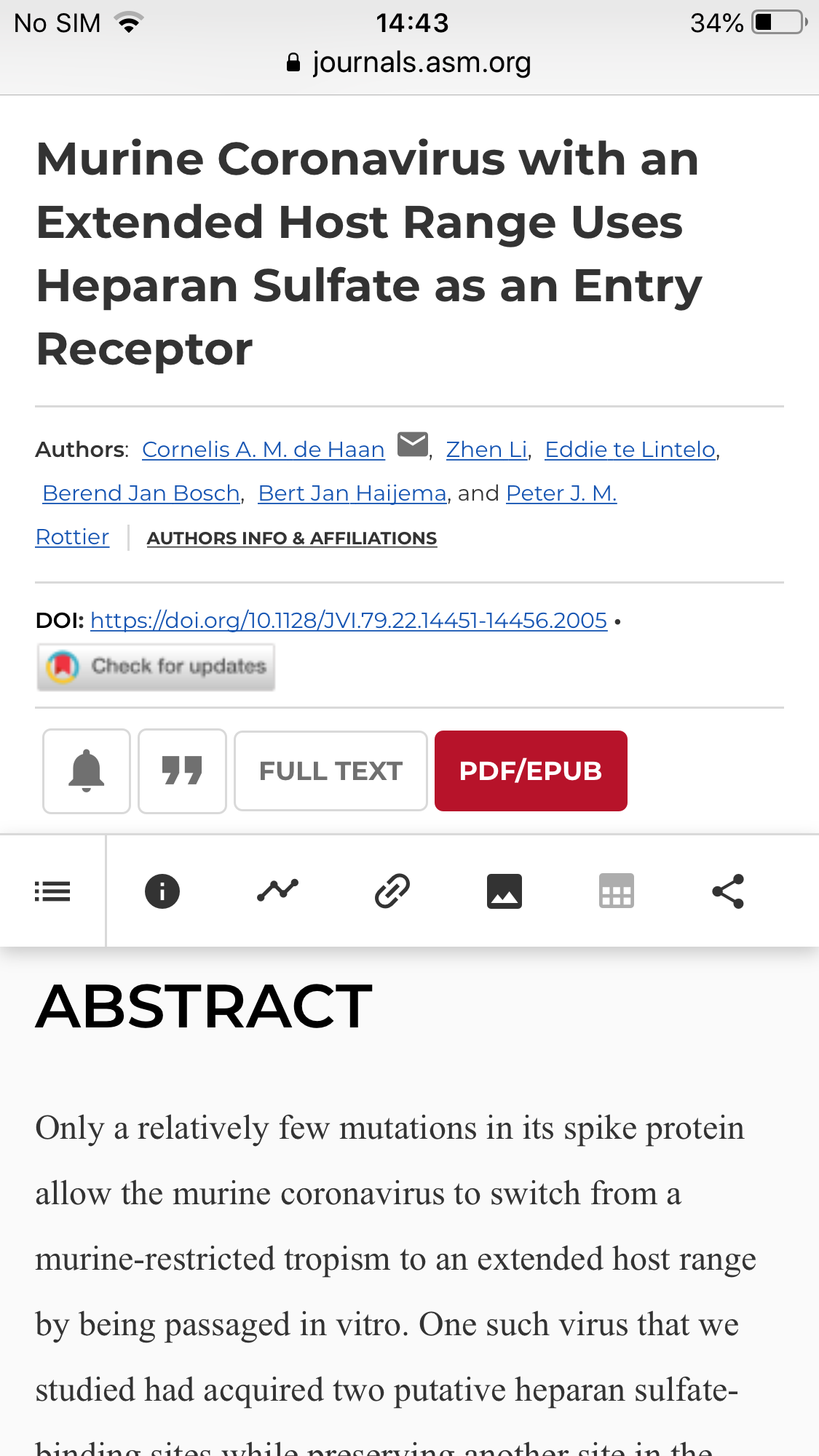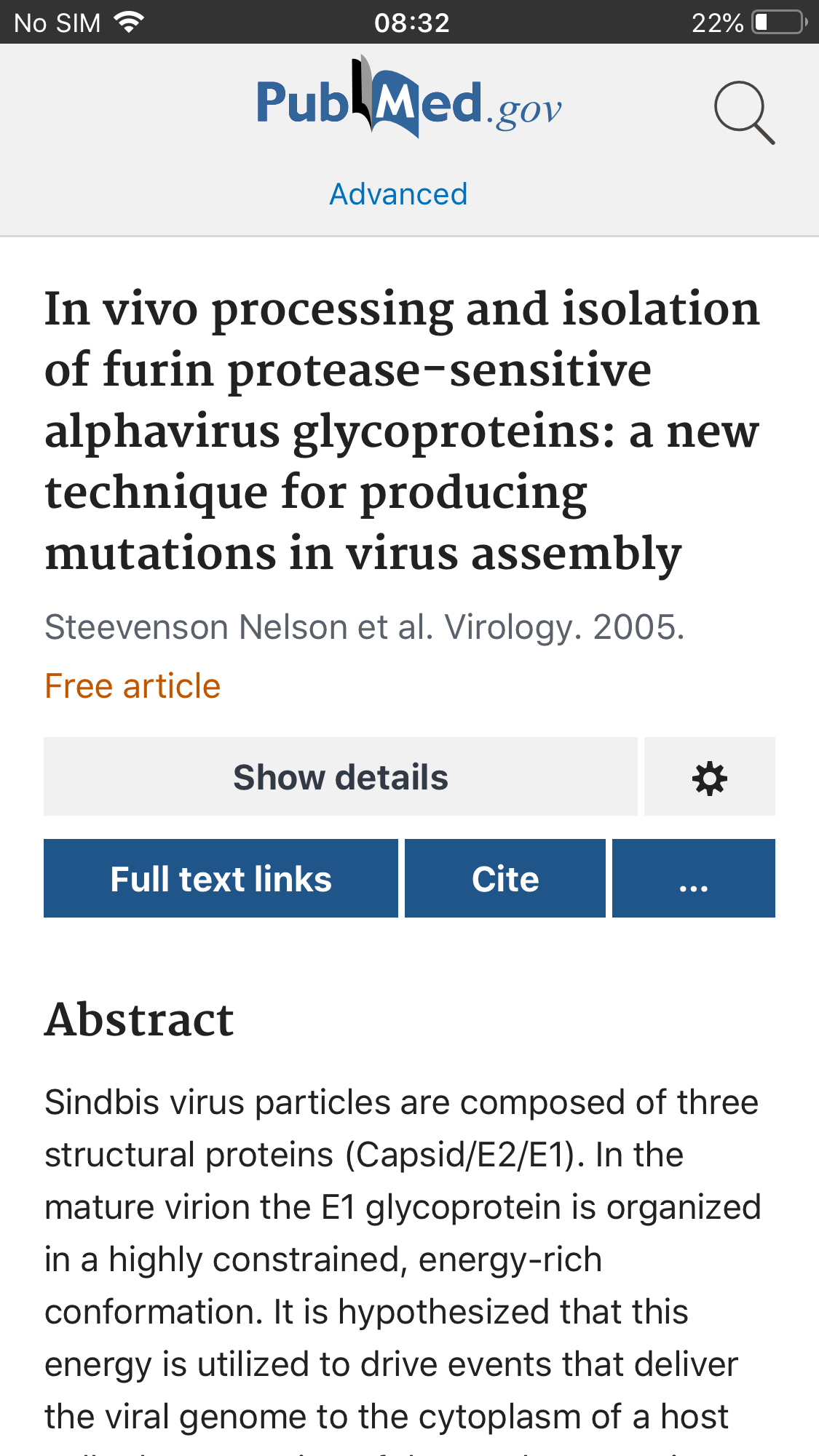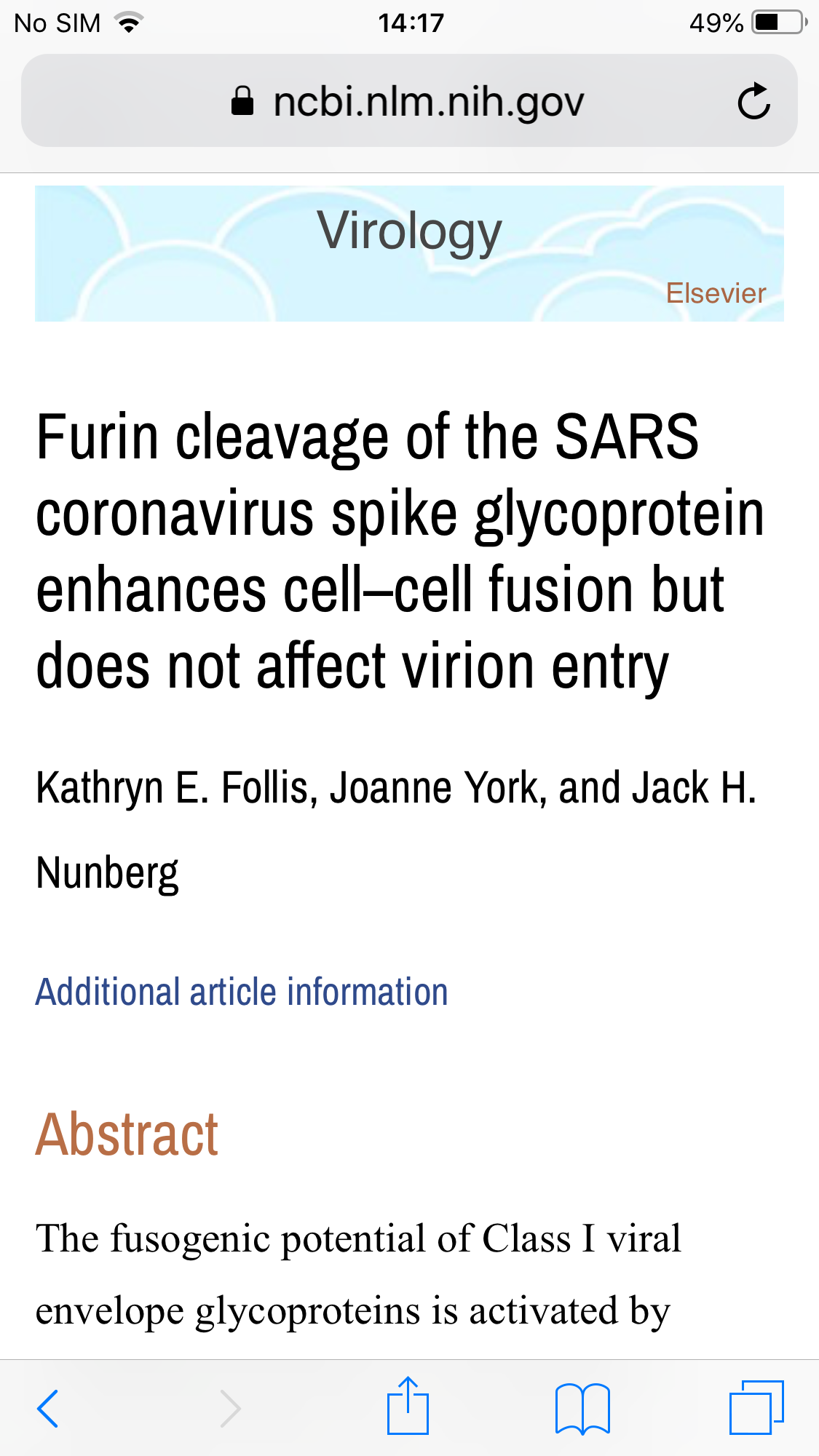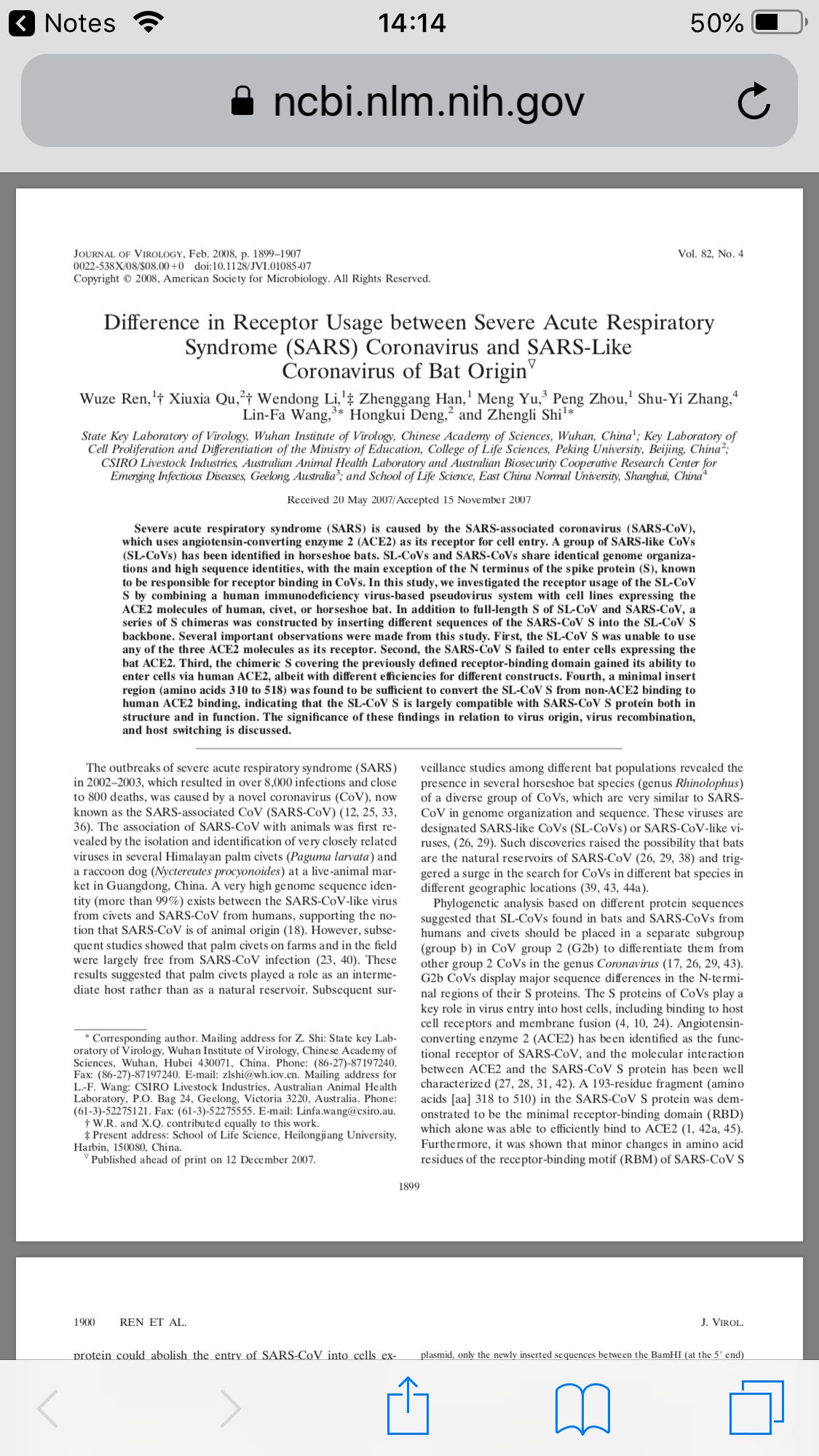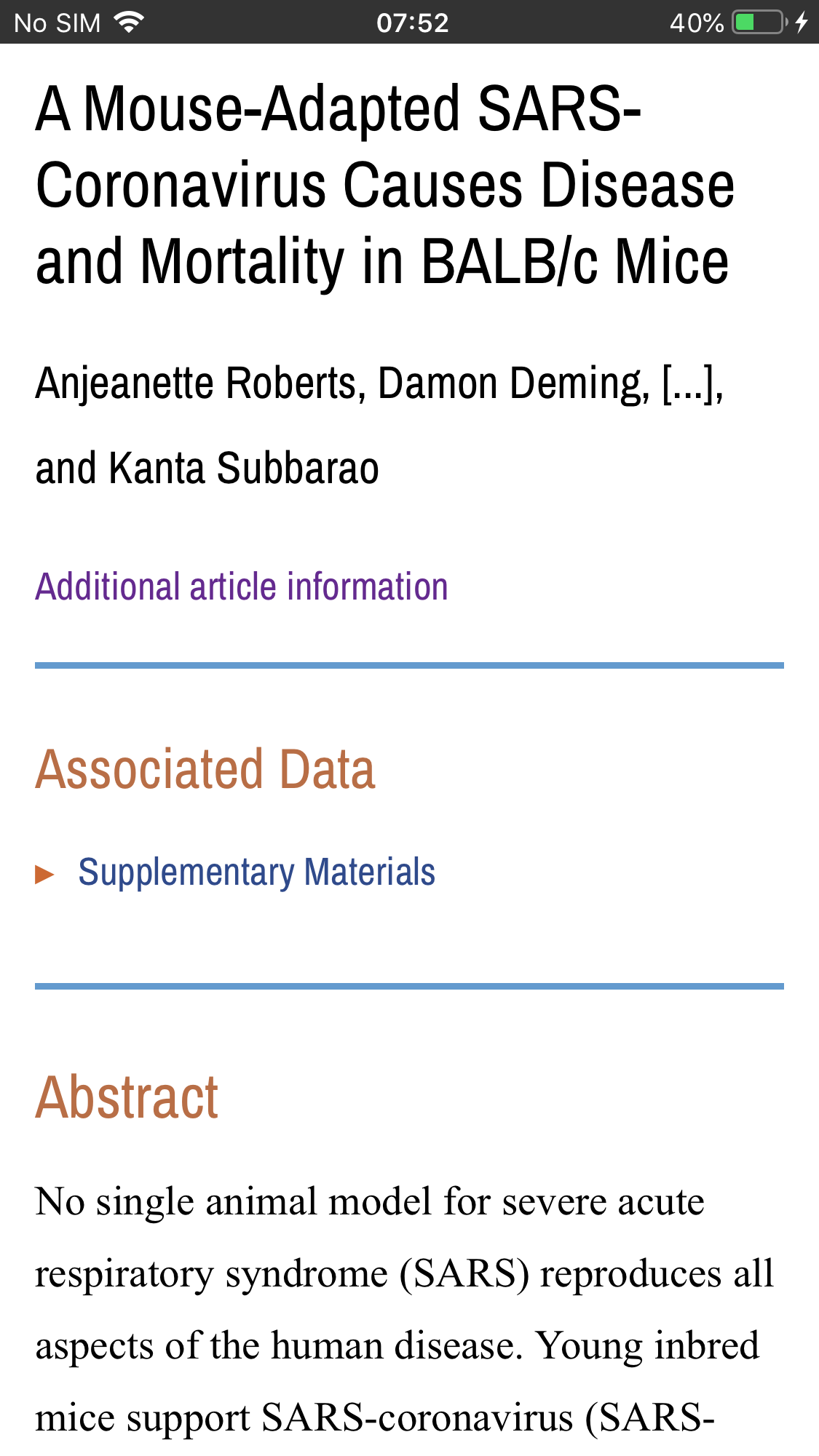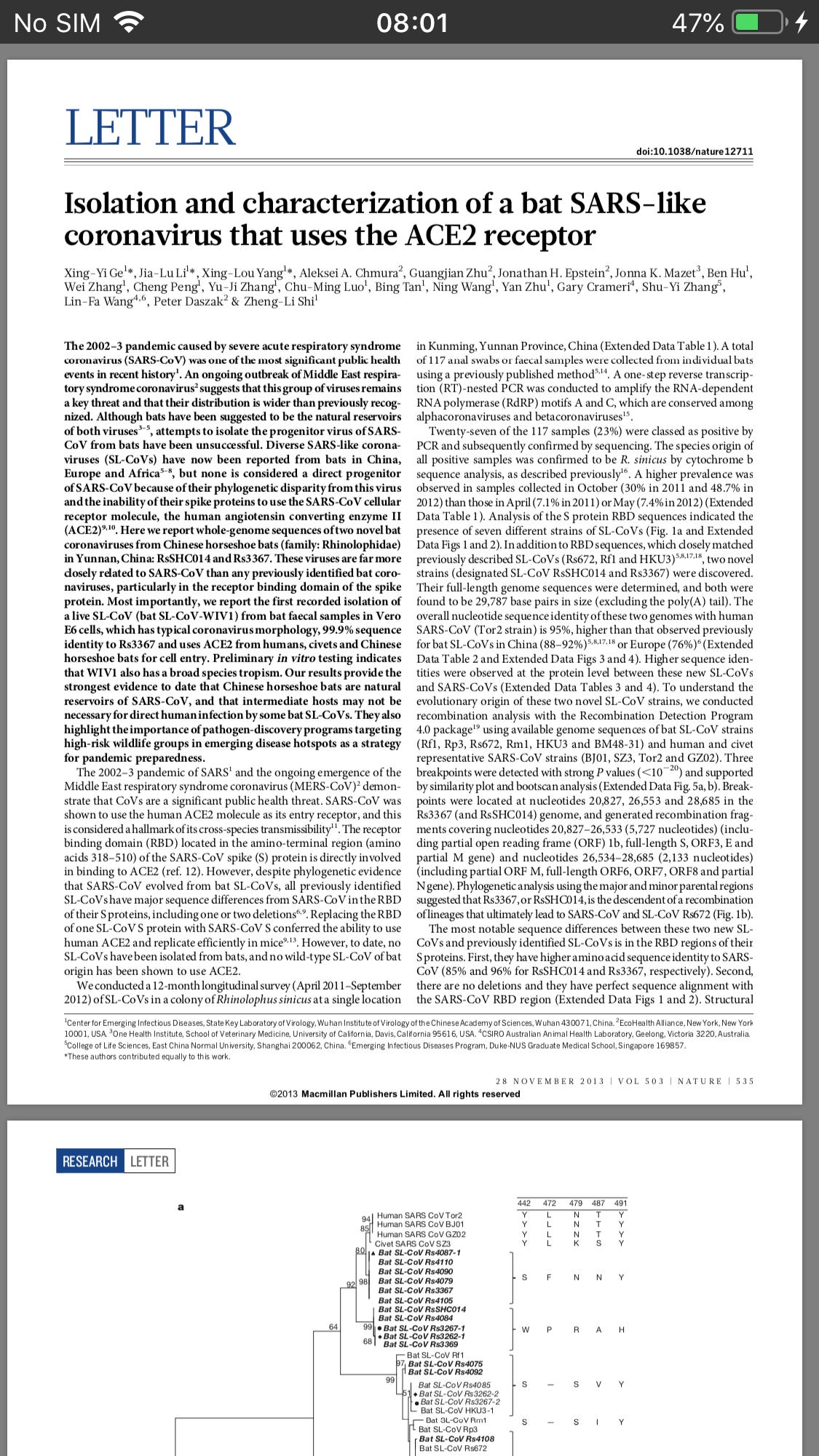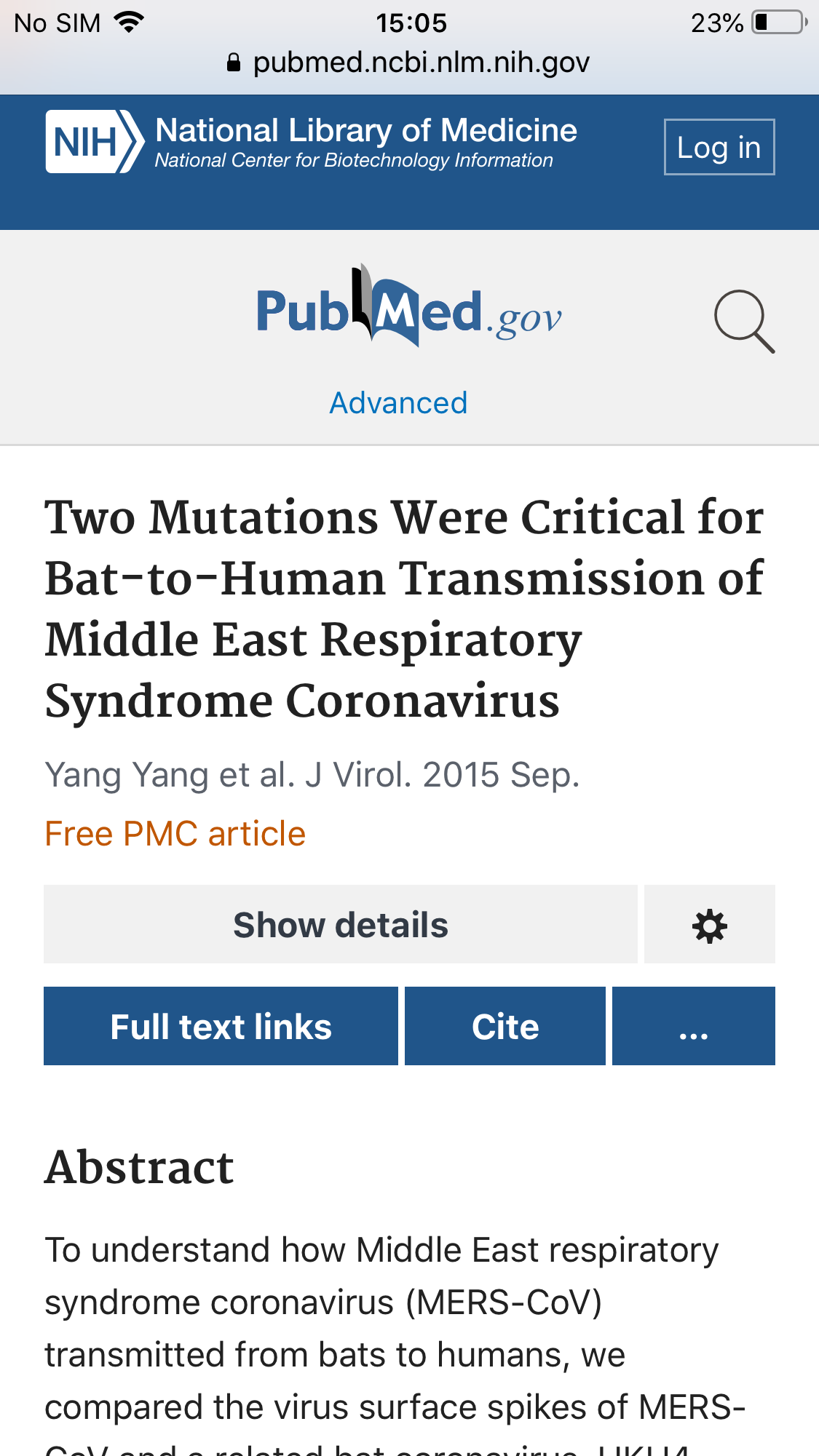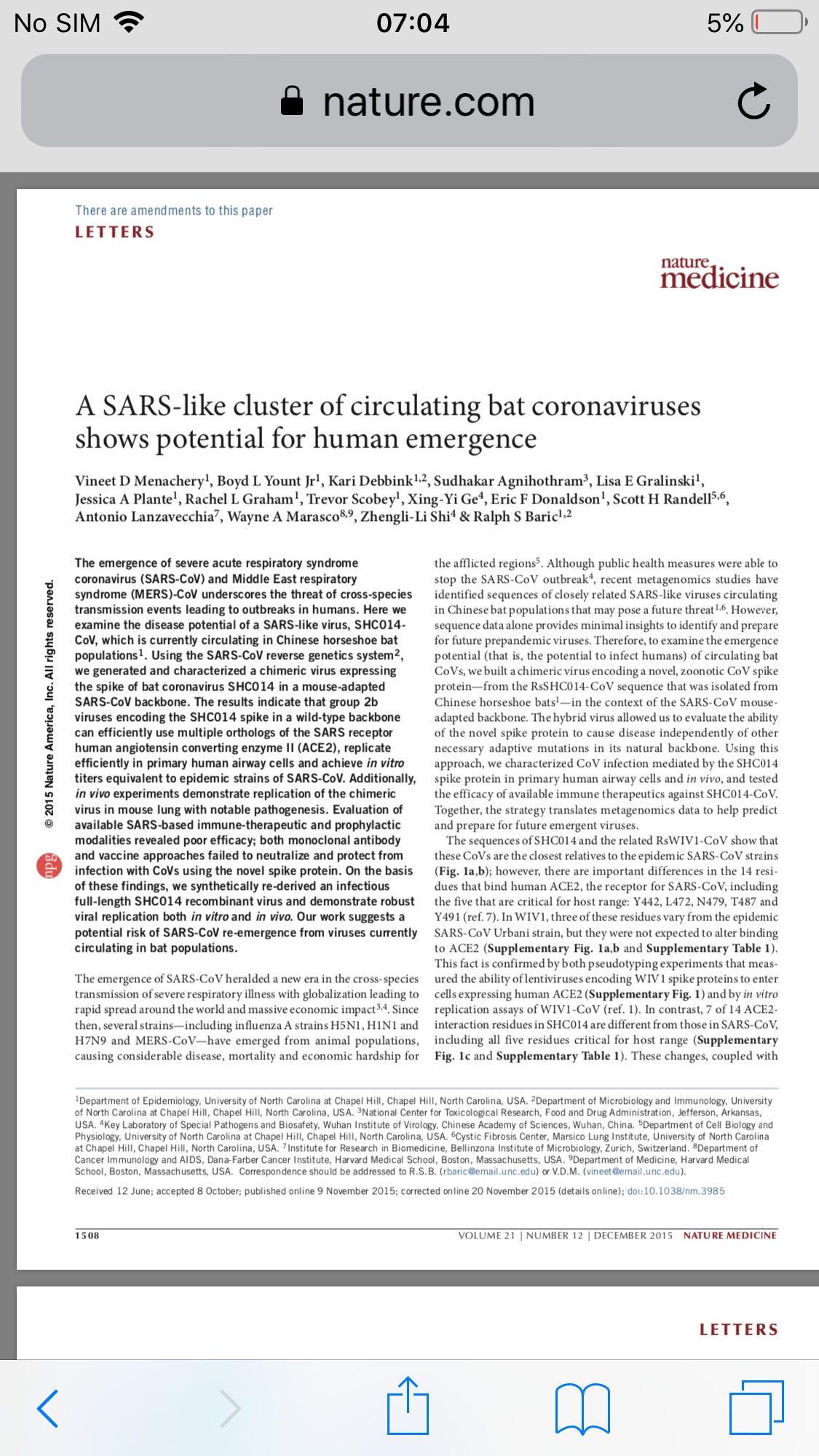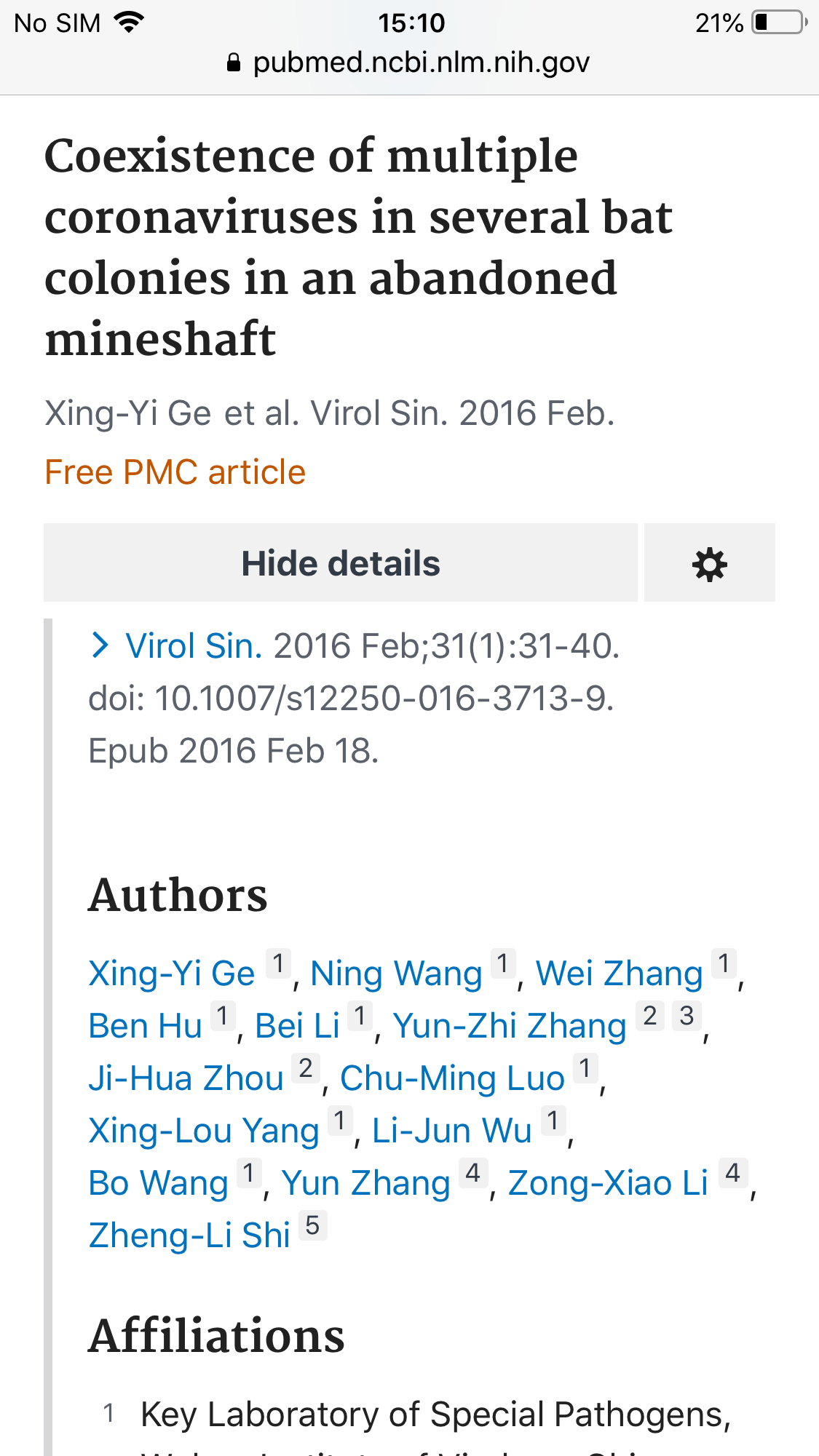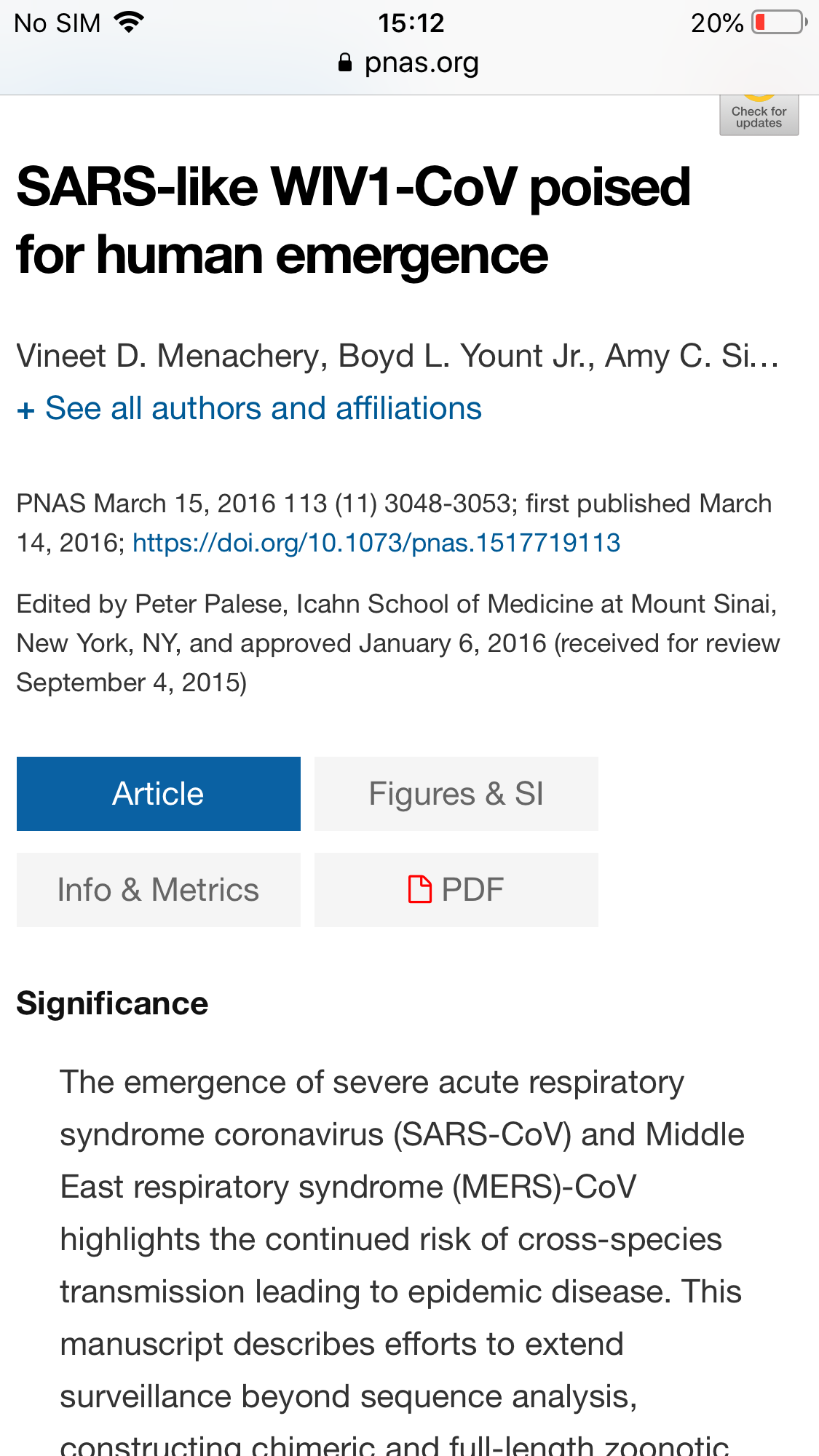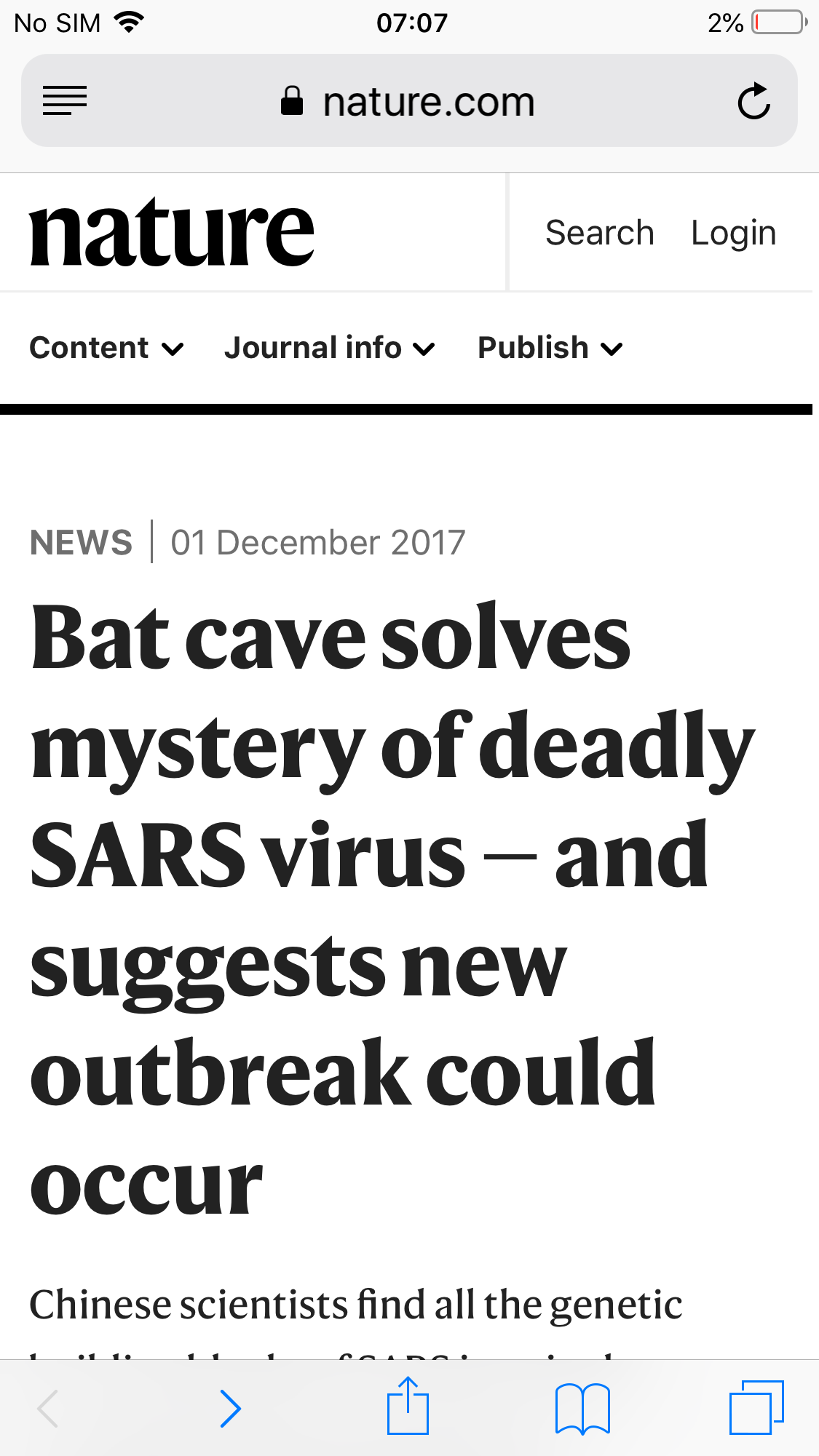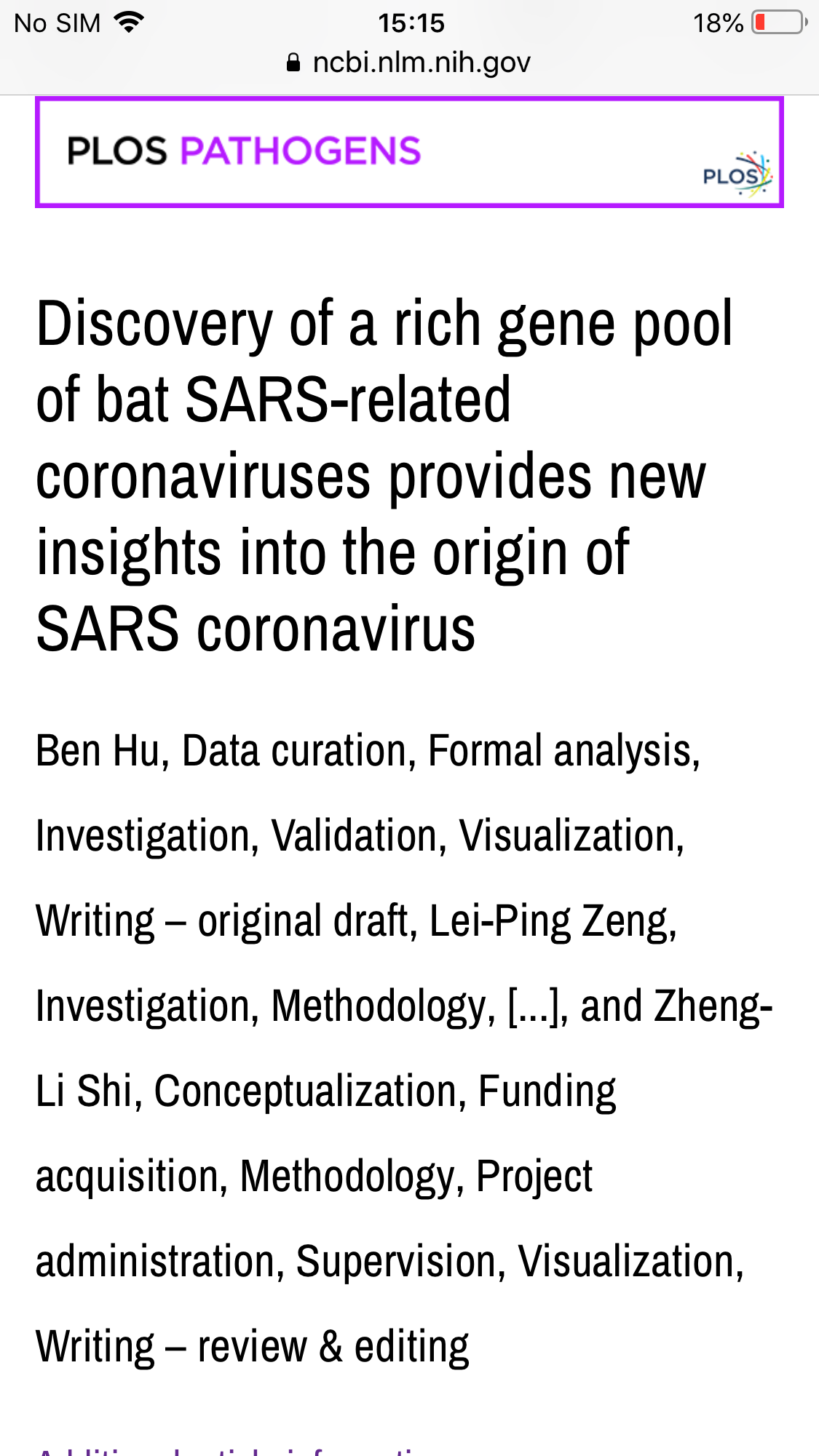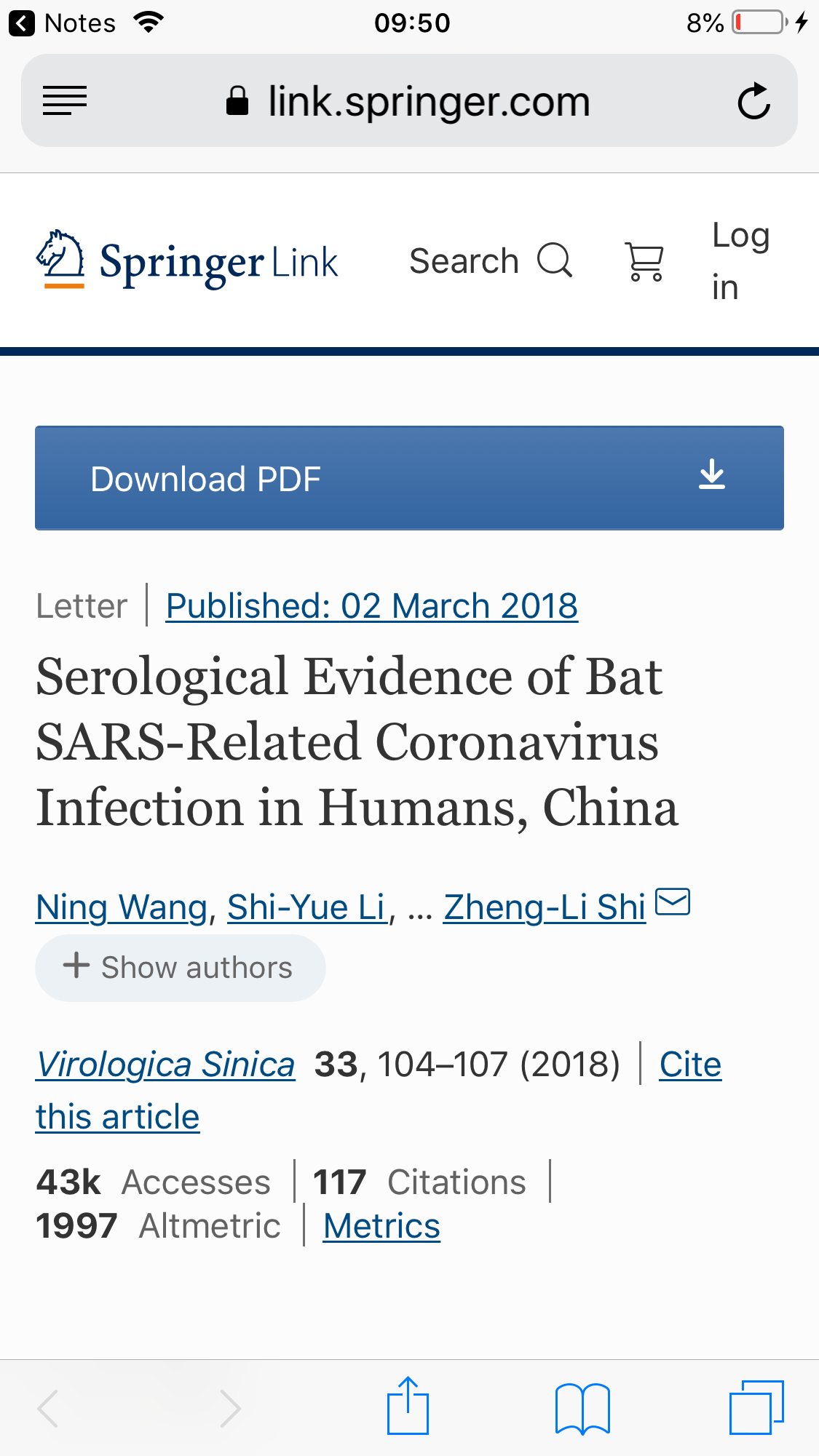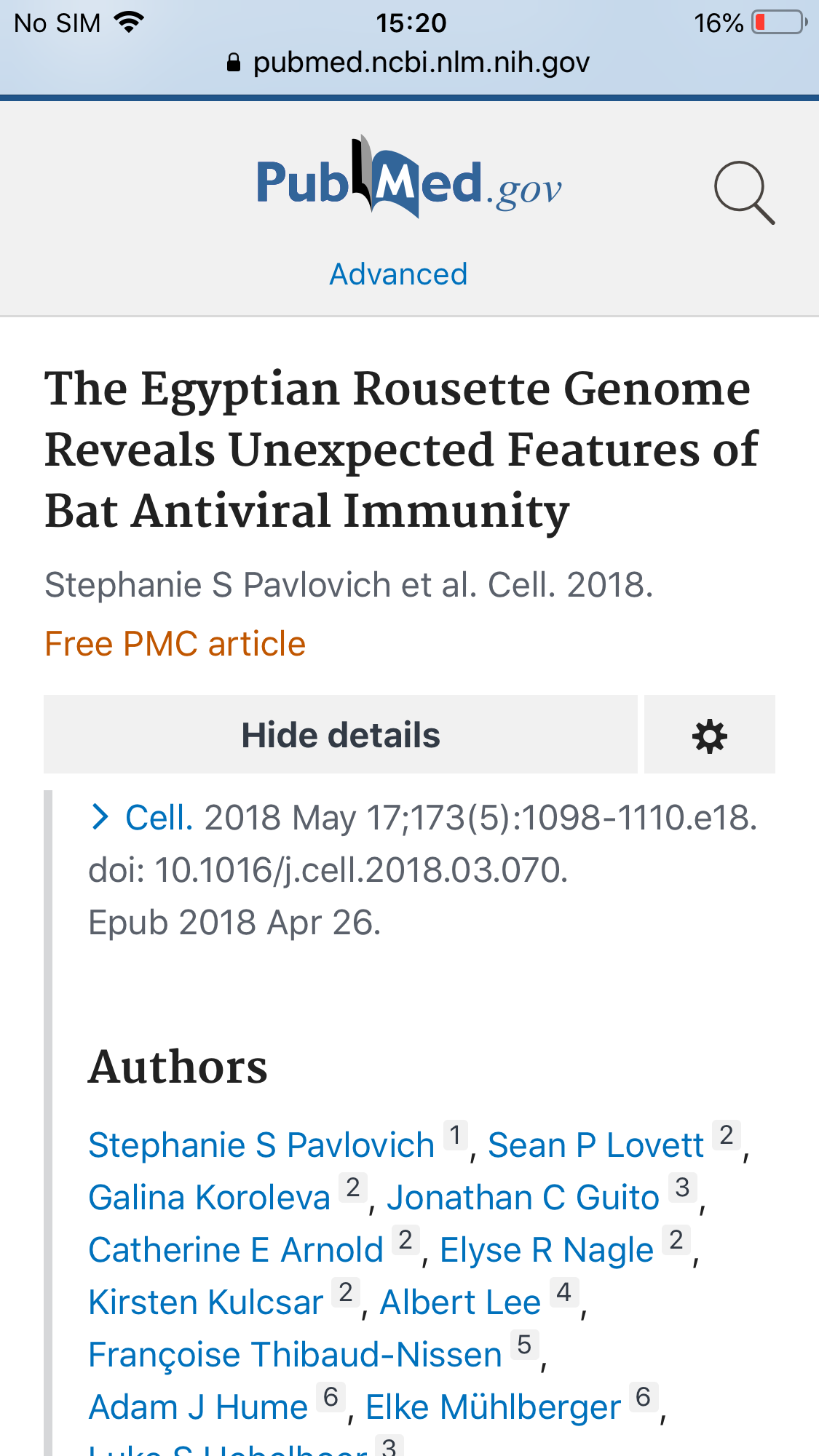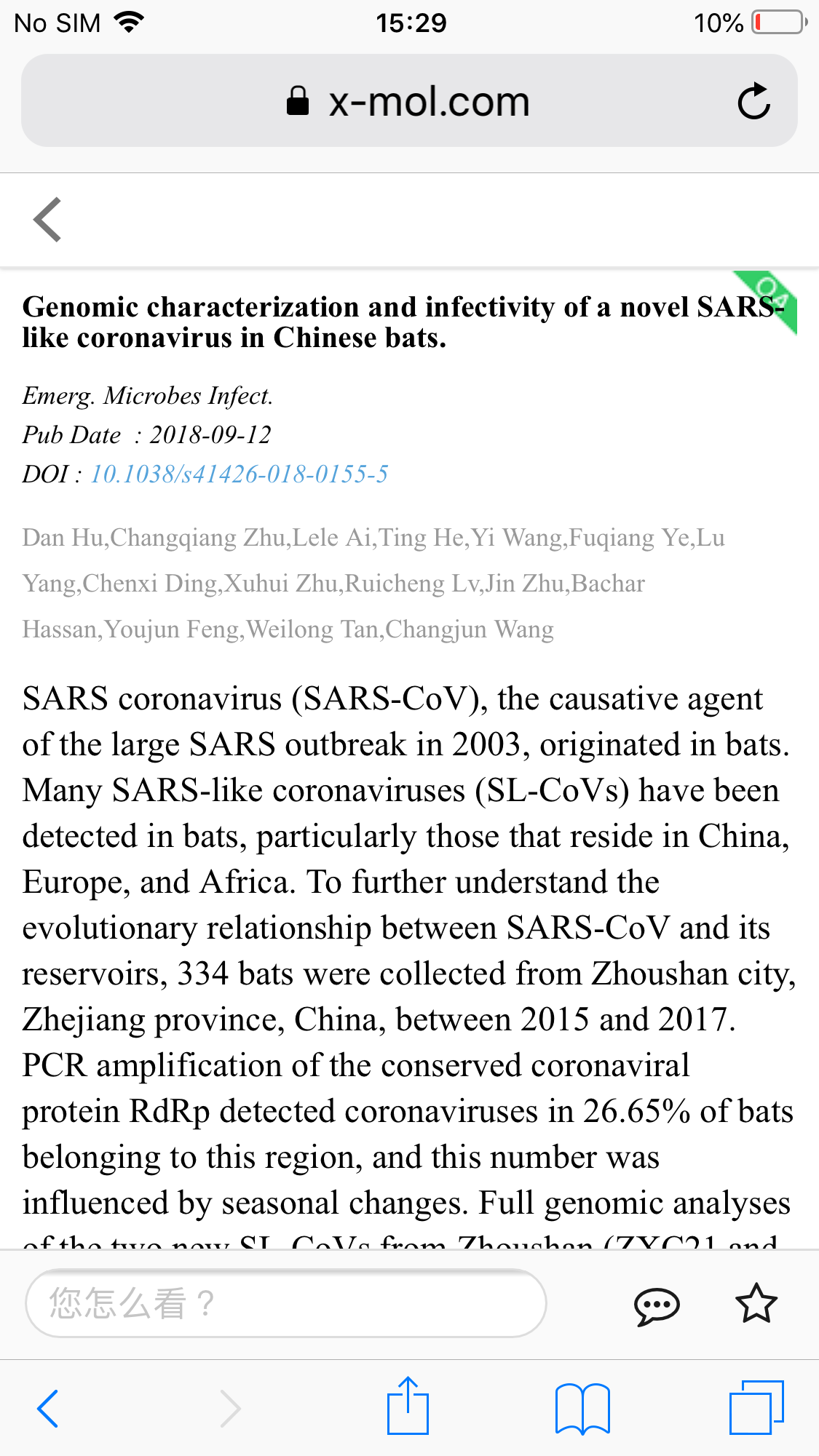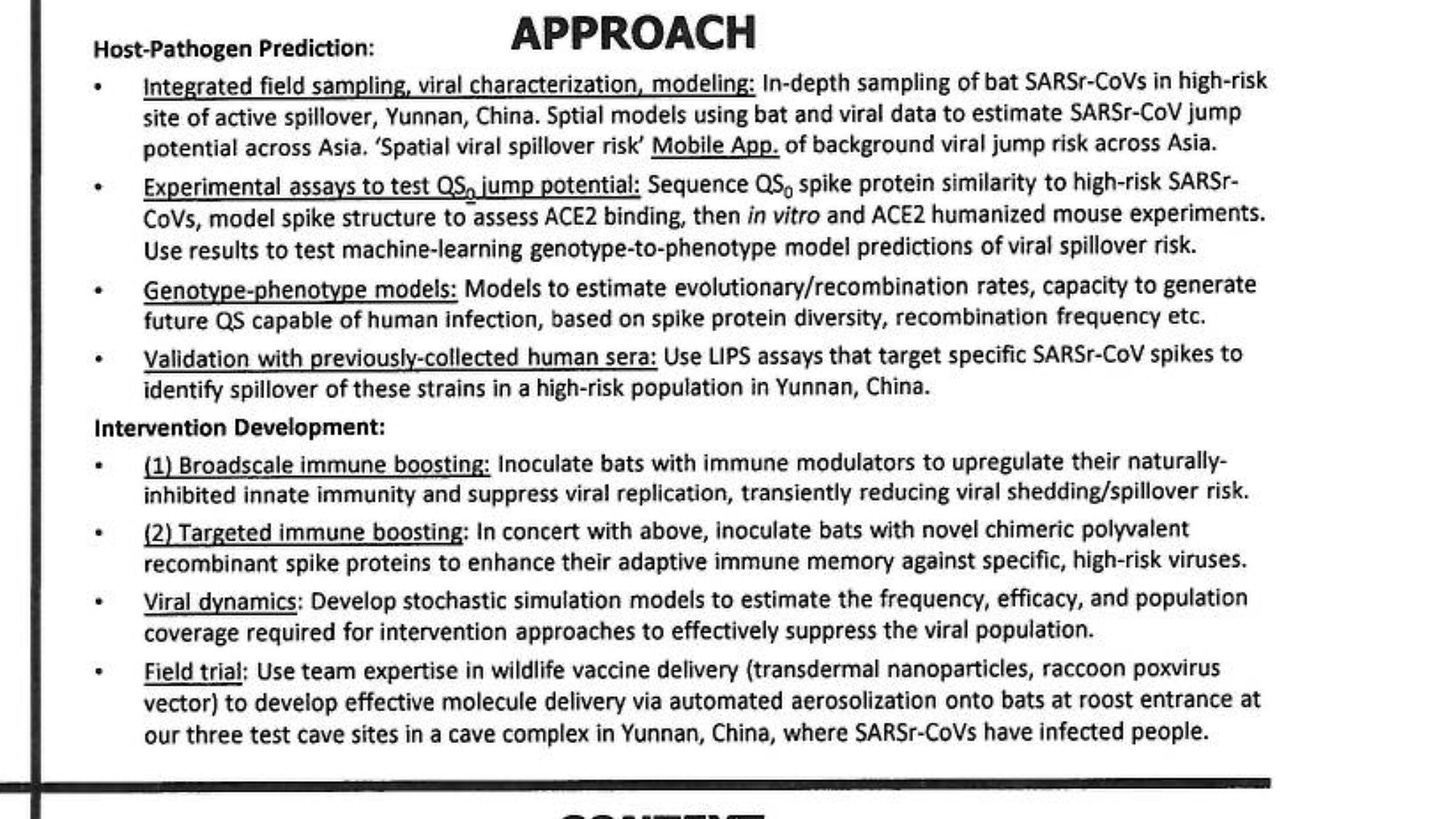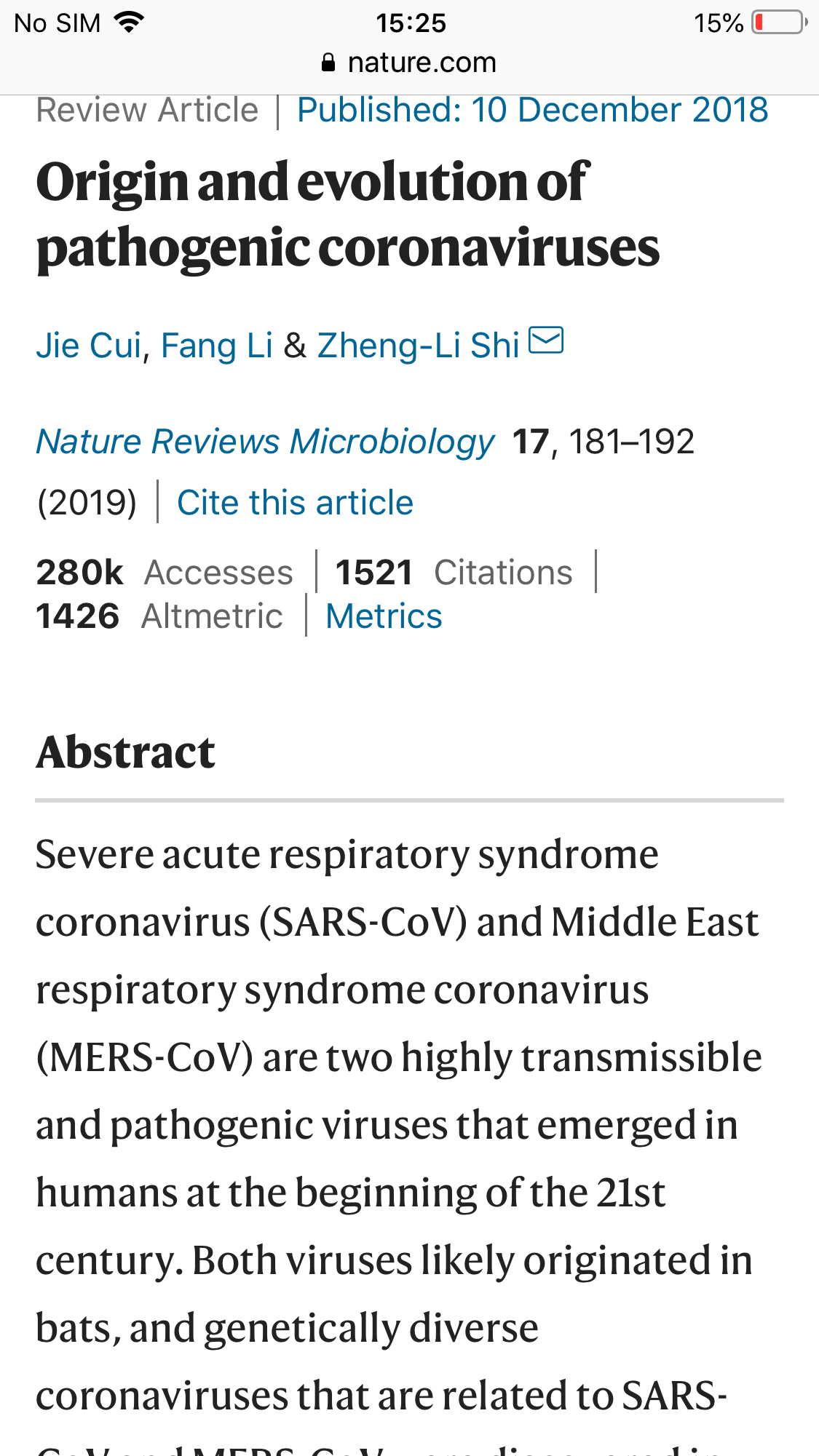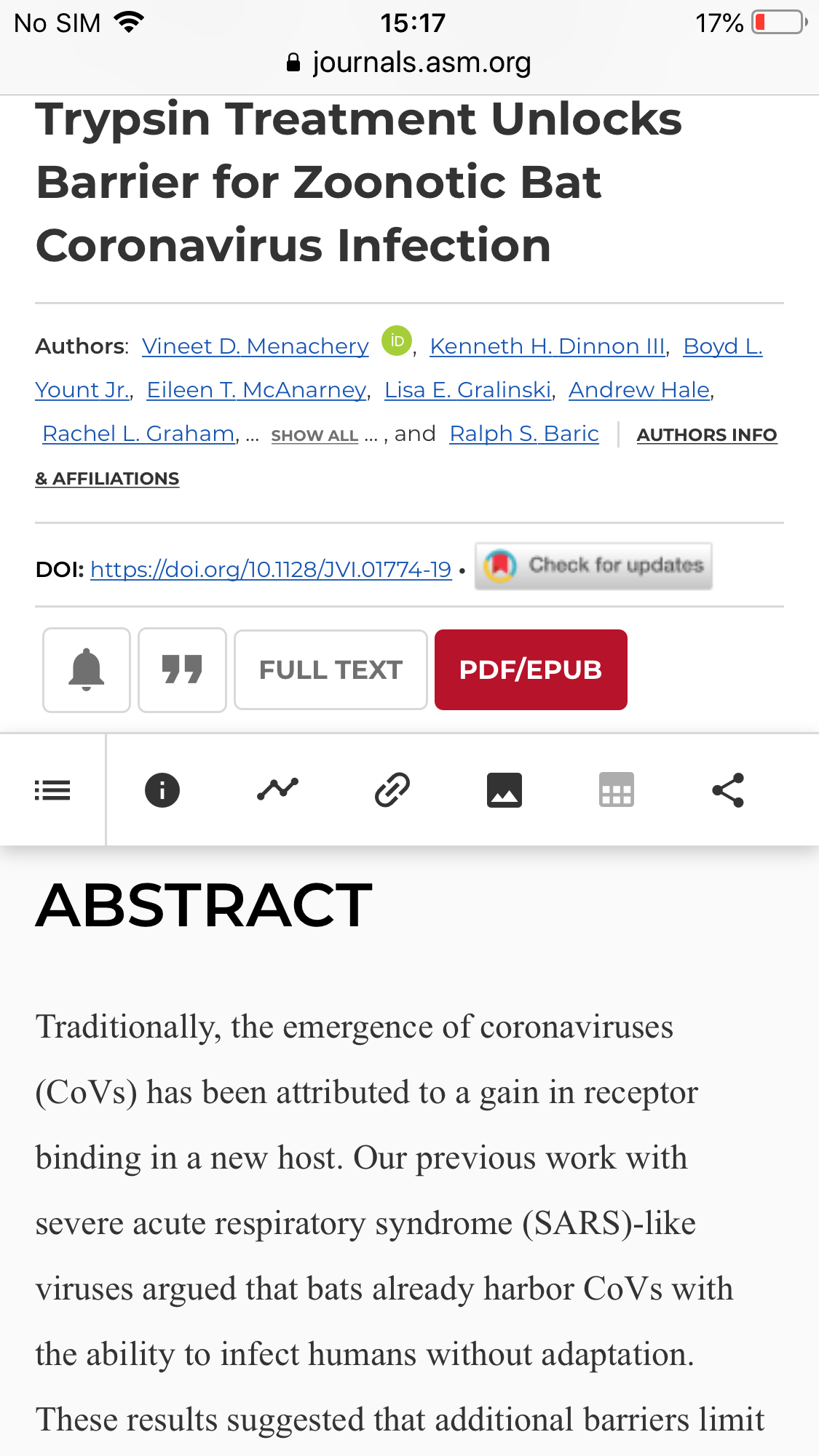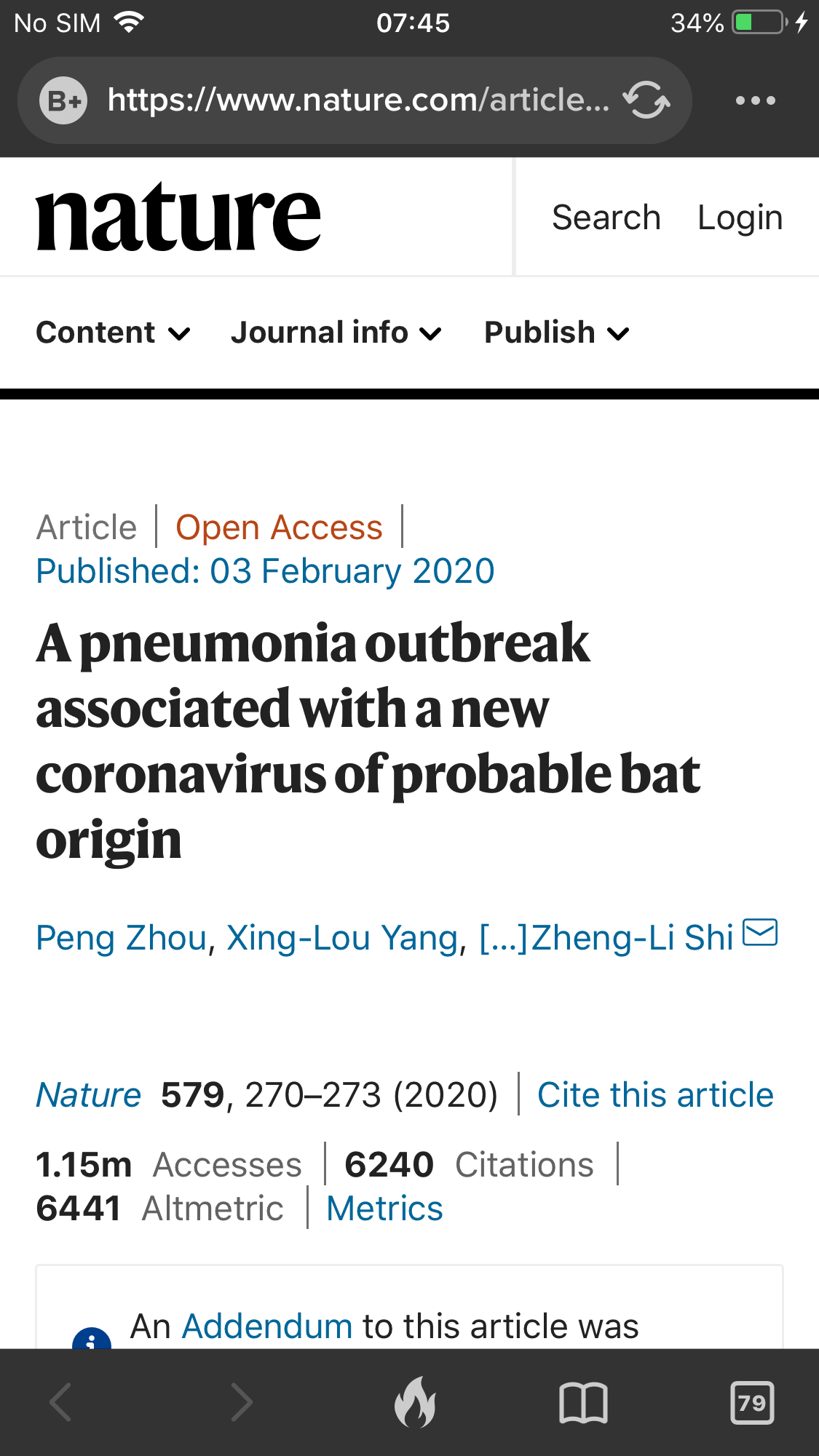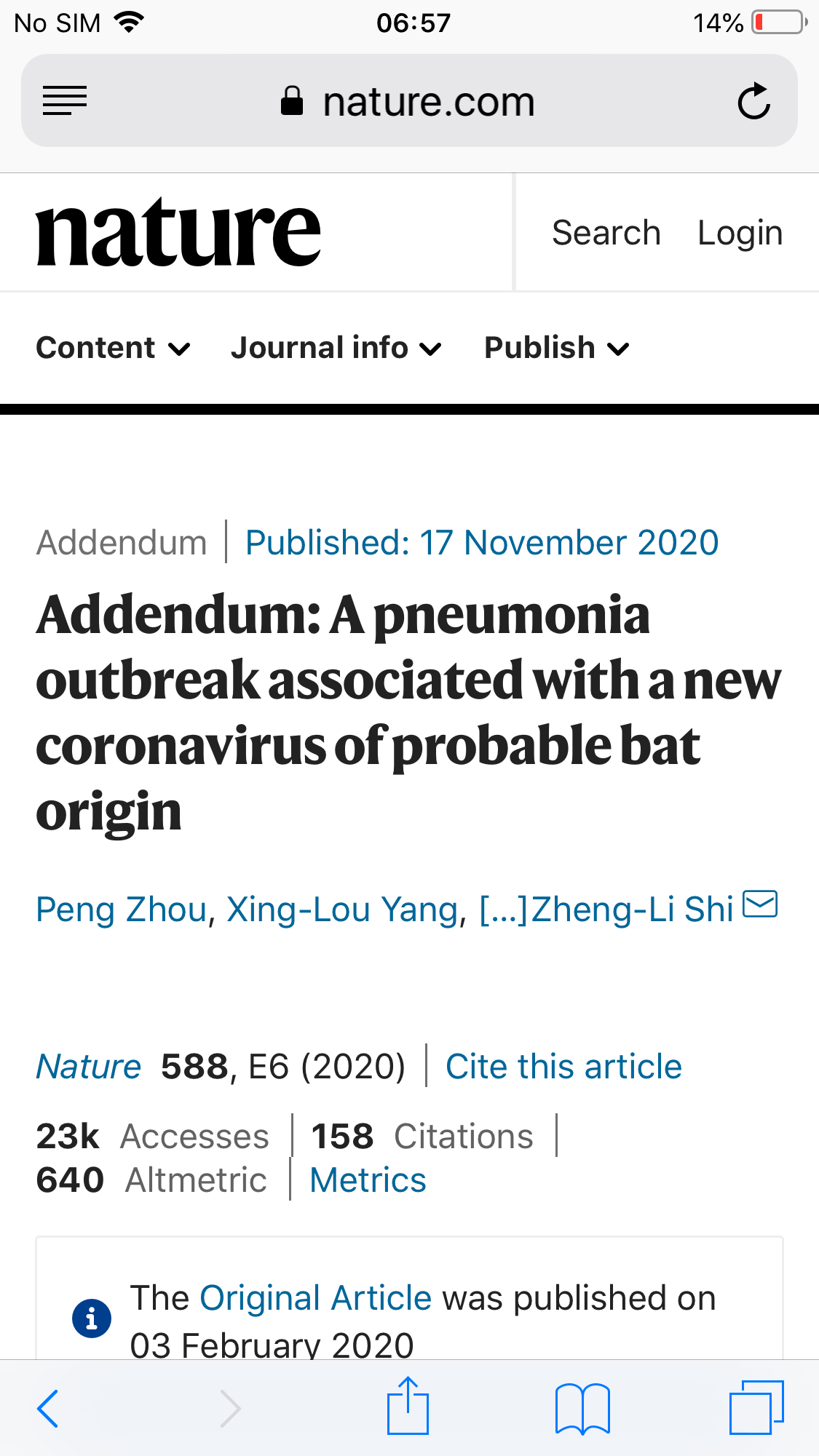Patents
Ralph Baric-UNC-2014
METHODS AND COMPOSITIONS FOR CHIMERIC CORONAVIRUS SPIKE PROTEINS
Shibo Jiang-2006
NEUTRALIZING MONOCLONAL ANTIBODIES AGAINST SARS CORONAVIRUS
https://patents.justia.com/patent/7629443
Dennis T Brown -NC State Univ-2004
Insertion of Furin Protease Cleavage Sites in Membrane Proteins and Uses Thereof.
In 2013 Chinese scientists demonstrated the capability to insert a furin polybasic cleavage site, similar to that of COVID-19, into a protein, an article which cited US patent “Insertion of Furin Protease Cleavage Sites in Membrane Proteins and Uses Thereof.”
https://pubmed.ncbi.nlm.nih.gov/24244593/
The holder of this patent is Dennis T Brown out of the NC State University , the same NC that Ralph Baric is based
One of the authors of that 2013 article, Chinese scientist Shibo Jiang, has a joint appointment at the Lindsley F. Kimball Research Institute in New York and Fudan University in Shanghai and is a long-time collaborator of Zheng-Li Shi and Ralph Baric in coronavirus research
Despite having the innocuous title “Simultaneous Expression of Displayed and Secreted Antibodies for Antibody Screen,” Shibo Jiang and his military-trained colleague Shuwen Liu, demonstrated the artificial insertion of a furin polybasic cleavage site similar to that found in the COVID-19 virus.
That study was directly funded by the Chinese government and a private Chinese biotech company, while Shibo Jiang was also being funded by Fauci’s NIAID.
There is no identified natural evolutionary pathway for the presence of the furin polybasic cleavage site found in COVID-19. It had to be artificially inserted.
Between 1987 and 1990, he received his postdoctoral training at the Rockefeller University in New York, largely through HIV AIDS funding provided by Dr. Anthony Fauci’s National Institute of Allergy and Infectious Diseases (NIAID).
CDC-2003
CORONAVIRUS ISOLATED FROM HUMANS
Ralph Baric -UNC-2002
METHODS FOR PRODUCING RECOMBINANT CORONAVIRUS
Also knownas the No See’em’ patent that allegedly allows reverse engineering on viruses to be used without leaving any traces of human-engineering
A year before SARS a patent was obtained by the ‘Godfather’ of coronavirus, Ralph Baric. Ralph Baric is a professor of microbiology and immunology at the Gillings School of Global Public Health at the University of North Carolina at Chapel Hill .
While the patent for the vaccine process is used for pigs, it can also cover human vaccines made from the same processes
Ralph Baric-2001
DIRECTIONAL ASSEMBLY OF LARGE VIRAL GENOMES AND CHROMOSOMES
The patent for that replication-defective coronavirus that attacks human lung cells was filed April 19, 2002 (Patent No. 7279327). “In other words, we made SARS,” Martin says. Or perhaps more accurately, Fauci and UNC did. Several months after that patent filing, the SARS outbreak in Asia occurred.
“That patent, issued as U.S. Patent 7279327 … clearly lays out in very specific gene sequencing, the fact that we knew that the ACE receptor, the ACE2 binding domain, the S-1 spike protein, and other elements of what we have come to know as this scourge pathogen, was not only engineered, but could be synthetically modified in the laboratory using nothing more than gene sequencing technologies.
Taking computer code and turning it into a pathogen, or an intermediate of the pathogen, and that technology was funded exclusively, in the early days, as a means by which we could harness coronavirus as a vector to distribute HIV vaccine.”
Papers
1999 paper from the Dutch group of Peter Rottier from Utrecht University with a revealing title Retargeting of Coronavirus by Substitution of the Spike Glycoprotein Ectodomain: Crossing the Host Cell Species Barrier.
Using targeted RNA recombination, they constructed a mutant of the coronavirus mouse hepatitis virus (MHV) The resulting chimeric virus, designated fMHV, acquired the ability to infect feline cells and simultaneously lost the ability to infect murine cells in tissue culture.
This work was supported in part by Public Health Service grant AI 39544 from the National Institutes of Health to P.S.M.
https://www.ncbi.nlm.nih.gov/pmc/articles/PMC111474/#__ffn_sectitle
2000-RB
A systematic method was developed to assemble functional full-length genomes of large RNA and DNA viruses. Coronaviruses contain the largest single-stranded positive-polarity RNA genome in nature. The ∼30-kb genome, coupled with regions of genomic instability, has hindered the development of a full-length infectious cDNA construct. We have assembled a full-length infectious construct of transmissible gastroenteritis virus (TGEV), an important pathogen in swine
This work was supported by a research grant from the National Institutes of Health (AI 23946).
https://pubmed.ncbi.nlm.nih.gov/11044104
2002-BEFORE the outbreak of the first SARS-CoV. Ralph Baric published a breakthrough work, which marked a milestone in both the study of various mechanisms of natural viruses and in gain-of-function research. In their paper, the Baric group described creating a synthetic clone of a natural murine coronavirus:
In essense, the authors “translated” the RNA virus into the language of DNA (using reverse transcriptase), which enabled them to manipulate its genome with the help of existing genetic engineering tools.
Having created 7 such cDNA provirus segments, the authors then stitched them together “seamlessly” after which they transcribed their construct back into RNA, which was then translated into virus particles in other cells.
https://journals.asm.org/doi/epub/10.1128/JVI.76.21.11065-11078.2002
2003 -After the first SARS-CoV epidemic broke out. The Baric group sprang into action. By summer of 2003, they had submitted a paper on synthetically recreating SARS-CoV:
Using a panel of contiguous cDNAs that span the entire genome, we have assembled a full-length cDNA of the SARS-CoV Urbani strain, and have rescued molecularly cloned SARS viruses that contained the expected marker mutations inserted into the component clones.
Recombinant viruses replicated as efficiently as WT virus and both were inhibited by treatment with the cysteine proteinase inhibitor…
Availability of a SARS-CoV full-length cDNA provides a template for manipulation of the viral genome, allowing for the rapid and rational development and testing of candidate vaccines and therapeutics against this important human pathogen.
Today, a qualified laboratory can repeat those steps in a matter of weeks. In fact, two just did: the Swiss have created a synthetic clone of CoV2 in under a month, while it took the Galveston BSL4 lab less than 2 months to do so.
This work was supported by National Institutes of Health Grants AI23946, GM63228 (to R.S.B.), and AI26603 (to M.R.D.). The research was supported by the Carolina Vaccine Institute at the University of North Carolina, Chapel Hill and USAMRIID at Ft Detrick
https://www.pnas.org/content/100/22/12995
2004- Shi Zheng Li joined an international team of researchers to collect samples from bat colonies in caves near Nanning, the capital of Guangxi.
Shi Tou Cave on the outskirts of Kunming, the capital of Yunnan, where they conducted intense sampling during different seasons over five consecutive years.
The efforts paid off. The pathogen hunters discovered hundreds of bat-borne coronaviruses with incredible genetic diversity. “The majority of them are harmless,” Shi says.
But dozens belong to the same groupas SARS. They can infect human lung cells in a petri dish and cause SARS-like diseases in mice.
2005 -Shi Zhengli coauthored a paper Peter Rottier but her address was listed at Shanghai Institute). That article itself is quite curious — in it the authors investigated what exactly allows viruses to expand their species tropism:
Only a relatively few mutations in its spike protein allow the murine coronavirus to switch from a murine-restricted tropism to an extended host range by being passaged in vitro.
One such virus studied had acquired two putative heparan sulfate-binding sites while preserving another site in the furin-cleavage motif.
It is interesting that the furin site in that virus (SRRAHR | SV) is similar to the site in CoV2 (SPRRAR | SV), although in CoV2 it is cut more efficiently due to dual arginines
This work was supported by grants from The Netherlands Organization for Scientific Research (NWO-VIDI-700.54.421) and the China Scholarship Council to C.A.M.d.H. and Z.L., respectively.
https://journals.asm.org/doi/full/10.1128/JVI.79.22.14451-14456.2005
2005-Dennis T Brown
This Research was supported by grants from the National Institutes of Health (AI-42775), The Foundation for Research (Carson City NV) and the North Carolina Agricultural Research Service.
https://pubmed.ncbi.nlm.nih.gov/15680428/
2006-Petet Rottier /Shi Zheng Li
Only a relatively few mutations in its spike protein allow the murine coronavirus to switch from a murine-restricted tropism to an extended host range by being passaged in vitro. One such virus that we studied had acquired two putative heparan sulfate-binding sites while preserving another site in the furin-cleavage motif. The adaptation of the virus through the use of heparan sulfate as an attachment/entry receptor was demonstrated by increased heparin binding as well as by inhibition of infection through treatment of cells and the virus with heparinase and heparin, respectively.
This work was supported by grants from The Netherlands Organization for Scientific Research (NWO-VIDI-700.54.421) and the China Scholarship Council to C.A.M.d.H. and Z.L., respectively.
https://www.ncbi.nlm.nih.gov/pmc/articles/PMC1280238/
2006-an American team had inserted RRSRR into the spike protein of the first SARS-CoV back :
To investigate whether proteolytic cleavage at the basic amino acid residues, were it to occur, might facilitate cell–cell fusion activity, they mutated the wild-type SARS-CoV glycoprotein to construct a prototypic furin recognition site (RRSRR) at either position
https://www.ncbi.nlm.nih.gov/pmc/articles/PMC7111780/#!po=0.568182
2007-. Shi Zhengli group joined the synthetic virology race with a study of the spike protein of human and bat coronaviruses, trying to determine what exactly is responsible for the ability to skip from one species to another
The Wuhan Institute of Virology and Shi Zhengli published a study in the Journal of Virology in which they combined a SARS-like virus from bats with human immunodeficiency virus (HIV) and created a chimera virus capable of infecting human cells
In the experiment, they also changed several key amino acids of bat ACE2 to test its binding to the S protein and constructed the HIV pseudovirus HIV / BJ01-S with the SARS virus BJ01-S protein.
This work was jointly funded by a State Key Program for Basic Research Grant (2005CB523004) from the Chinese Ministry of Sci- ence and Technology, a special fund from the president of the Chinese Academy of Sciences (no. 1009), the Knowledge Innovation Program Key Project of the Chinese Academy of Sciences (KSCX1-YW-R-07) to Z. Shi, the Sixth Framework Program “EPISARS” of the European Commission, a National Nature Science Foundation of China for Creative Research group grant (30421004) to H. Deng, and the Australian Biosecurity CRC for Emerging Infectious Diseases (project 1.026RE) to L.-F. Wang.
https://www.ncbi.nlm.nih.gov/pmc/articles/PMC2258702/pdf/1085-07.pdf
2007-Ralph Baric
We adapted the SARS-CoV (Urbani strain) by serial passage in the respiratory tract of young BALB/c mice. Fifteen passages resulted in a virus (MA15) that is lethal for mice following intranasal inoculation. Lethality is preceded by rapid and high titer viral replication in lungs, viremia, and dissemination of virus to extrapulmonary sites accompanied by lymphopenia, neutrophilia, and pathological changes in the lungs. Abundant viral antigen is extensively distributed in bronchial epithelial cells and alveolar pneumocytes, and necrotic cellular debris is present in airways and alveoli, with only mild and focal pneumonitis.
Funding. This research was supported in part by the Intramural Research Program of the US National Institutes of Health (NIH), NIAID, and in part by NIH/NIAID grants AI059136 and AI059443.
https://www.ncbi.nlm.nih.gov/pmc/articles/PMC1769406/#!po=85.2000
2012- Shi’s team had been called in to investigate the virus profile of a mine shaft in Yunnan’s mountainous Mojiang County—famous for its fermented Pu’er tea—where six miners suffered from pneumonialike diseases and two died.
After sampling the cave for a year, the researchers discovered a diverse group of coronaviruses in six bat species. In many cases, multiple viral strains had infected a single animal, turning it into a flying factory for new viruses.
“The mine shaft stunk like hell,” says Shi, who, like her colleagues, went in wearing a protective mask and clothing. “Bat guano, covered in fungus, littered the cave.”
Although she said in July 2020 the fungus turned out to be the pathogen that had sickened the miners, she says it would have been only a matter of time before they caught the coronaviruses if the mine had not been promptly shut.
Two months later she said she suspected they had an unknown virus
2013- Analyzing samples obtained in 2011-2012 In Shitou Cave—a coronavirus strain was found that came from horseshoe bats with a genomic sequence nearly 97 percent identical to the one found in civets in Guangdong.
The finding concluded a decade-long search for the natural reservoir of the SARS coronavirus.
Shi Zhengli and Peter Daszak announced their discovery of RsSHC014 in their 2013 paper, “Isolation and Characterization of a Bat SARS-Like Coronavirus that Uses the ACE2 Receptor,” and stated that it was found during “a 12-month longitudinal survey (April 2011–September 2012) of SL-CoVs in a colony of Rhinolophus sinicus at a single location in Kunming, Yunnan Province, China.”
financial support from the State Key Program for Basic Research (2011CB504701 and 2010CB530100), National Natural Science Foundation of China (81290341 and 31321001), Scientific and technological basis special project (2013FY113500), CSIRO OCE Science Leaders Award, National Institute of Allergy and Infectious Diseases (NIAID) award number R01AI079231, a National Institutes of Health (NIH)/National Science Foundation (NSF) ‘Ecology and Evolution of Infectious Diseases’ award from the NIH Fogarty International Center (R01TW005869), an award from the NIH Fogarty International Center supported by International Influenza Funds from the Office of the Secretary of the Department of Health and Human Services (R56TW009502), and United States Agency for International Development (USAID) Emerging Pandemic Threats PREDICT
Shi Zhengli received a $665,000 grant from NIH(NIAID R01 AI1 10964) as well as $559,500 more from USAID (a DOD partner) PREDICT_2 (Project No. AID-OAA-A-14-00102).
https://www.nature.com/articles/nature12711.pdf
2015-Shi Zheng Li/Ralph Baric
We compared the virus surface spikes of MERS-CoV and a related bat coronavirus, HKU4. Although HKU4 spike cannot mediate viral entry into human cells, two mutations enabled it to do so by allowing it to be activated by human proteases. These mutations are present in MERS-CoV spike, explaining why MERS-CoV infects human cells. These mutations therefore played critical roles in the bat-to-human transmission of MERS-CoV, either directly or through intermediate hosts
This work was supported by NIH grants R01AI089728; (to F.L.) and R01AI110700 (to R.S.B. and F.L.).
https://pubmed.ncbi.nlm.nih.gov/26063432/
2015-Shi Zheng Li/Ralph Baric
Ralph Baric and Shi Zhengli published a study in which they created a synthetic chimeric virus:
Using the SARS-CoV reverse genetics system, we generated and characterized a chimeric virus expressing the spike of bat coronavirus SHC014 in a mouse-adapted SARS-CoV backbone.
The results indicate that group 2b viruses encoding the SHC014 spike in a wild-type backbone can efficiently use multiple orthologs of the SARS receptor human angiotensin converting enzyme II (ACE2) and replicate efficiently in primary human airway cells
Additionally, in vivo experiments demonstrate replication of the chimeric virus in mouse lung with notable pathogenesis.
On the basis of these findings, we synthetically re-derived an infectious full-length SHC014 recombinant virus and demonstrate robust viral replication both in vitro and in vivo.
In other words they took the spike-like protein from RsSHC014, which Shi Zhengli isolated from Yunnan bats in 2011, and inserted it into a murine-adapted variant of SARS-CoV for subsequent in vivo experiments.
They also tested it in human cells, and almost as an aside created a recombinant clone of the same RsSHC014 strain:
The researchers also uncovered that the SHC014-MA15 chimera was more virulent than SHC014 itself, even in human cells and that the ability of a spike protein to be cleaved by proteases (including furin) can have an impact on virulence.
Simon Wain-Hobson, a virologist at the Pasteur Institute in France, expressed this concern deeply, telling Nature: “If the (new) virus escapes, no one can Predict its path.”
Research in this manuscript was supported by grants from the National Institute of Allergy & Infectious Disease and the National Institute of Aging of the US National Institutes of Health (NIH) under awards U19AI109761 (R.S.B.), U19AI107810 (R.S.B.), AI085524 (W.A.M.), F32AI102561 (V.D.M.) and K99AG049092 (V.D.M.), and by the National Natural Science Foundation of China awards 81290341 (Z.-L.S.) and 31470260 (X.-Y.G.), and by USAID-EPT-PREDICT funding from EcoHealth Alliance (Z.-L.S.).
Human airway epithelial cultures were supported by the National Institute of Diabetes and Digestive and Kidney Disease of the NIH under award NIH DK065988 (S.H.R.). We also thank M.T. Ferris (Dept. of Genetics, University of North Carolina) for the reviewing of statistical approaches and C.T. Tseng (Dept. of Microbiology and Immunology, University of Texas Medical Branch) for providing Calu-3 cells.
Experiments with the full-length and chimeric SHC014 recombinant viruses were initiated and performed before the GOF research funding pause and have since been reviewed and approved for continued study by the NIH. The content is solely the responsibility of the authors and does not necessarily represent the official views of the NIH.
AUTHoR conTRIBUTIonS
V.D.M. designed, coordinated and performed experiments, completed analysis and wrote the manuscript. B.L.Y. designed the infectious clone and recovered chimeric viruses; S.A. completed neutralization assays; L.E.G. helped perform mouse experiments; T.S. and J.A.P. completed mouse experiments and plaque assays; X.-Y.G. performed pseudotyping experiments; K.D. generated structural figures and predictions; E.F.D. generated phylogenetic analysis; R.L.G. completed RNA analysis; S.H.R. provided primary HAE cultures; A.L. and W.A.M. provided critical monoclonal antibody reagents; and Z.-L.S. provided SHC014 spike sequences and plasmids. R.S.B. designed experiments and wrote manuscript.
BLY-Boyd L Yount Jr
Department of Epidemiology, University of North Carolina at Chapel Hill, Chapel Hill, North Carolina, USA
In the original version of the article the authors omitted to acknowledge a funding source, USAID-EPT-PREDICT funding from EcoHealth Alliance,
https://www.nature.com/articles/nm.3985
2015-Shi Zheng Li/Ralph Baric
https://www.nature.com/articles/nm.3985.pdf
2016-Shi Zheng Li
We conducted a surveillance of coronaviruses in bats in an abandoned mineshaft in Mojiang County, Yunnan Province, China, from 2012-2013. Six bat species were frequently detected in the cave: Rhinolophus sinicus, Rhinolophus affinis, Hipposideros pomona, Miniopterus schreibersii, Miniopterus fuliginosus, and Miniopterus fuscus. By sequencing PCR products of the coronavirus RNA-dependent RNA polymerase gene (RdRp), we found a high frequency of infection by a diverse group of coronaviruses in different bat species in the mineshaft. Sequenced partial RdRp fragments had 80%-99% nucleic acid sequence identity with well-characterized Alphacoronavirus species, including BtCoV HKU2, BtCoV HKU8, and BtCoV1, and unassigned species BtCoV HKU7 and BtCoV HKU10. Additionally, the surveillance identified two unclassified betacoronaviruses, one new strain of SARS-like coronavirus, and one potentially new betacoronavirus species. Furthermore, coronavirus co-infection was detected in all six bat species, a phenomenon that fosters recombination and promotes the emergence of novel virus strains
https://pubmed.ncbi.nlm.nih.gov/26920708/
2016-Ralph Baric
This manuscript describes efforts to extend surveillance beyond sequence analysis, constructing chimeric and full-length zoonotic coronaviruses to evaluate emergence potential. Focusing on SARS-like virus sequences isolated from Chinese horseshoe bats, the results indicate a significant threat posed by WIV1-CoV. Both full-length and chimeric WIV1-CoV readily replicated efficiently in human airway cultures and in vivo, suggesting capability of direct transmission to humans. In addition, while monoclonal antibody treatments prove effective, the SARS-based vaccine approach failed to confer protection.Together, the study indicates an ongoing threat posed by WIV1-related viruses and the need for continued study and surveillance.
We thank Dr. Zhengli-Li Shi of the Wuhan Institute of Virology for access to bat CoV sequences and plasmid of WIV1-CoV spike protein. Research was supported by the National Institute of Allergy and Infectious Disease and the National Institute of Aging of the NIH under Awards U19AI109761 and U19AI107810 (to R.S.B.), AI1085524 (to W.A.M.), and F32AI102561 and K99AG049092 (to V.D.M.
https://www.pnas.org/content/113/11/3048.full
2017-Shi Zheng Li
In a remote cave in Yunnan province, virologists have identified a single population of horseshoe bats that harbours virus strains with all the genetic building blocks of the one that jumped to humans in 2002, killing almost 800 people around the world.
https://www.nature.com/articles/d41586-017-07766-9
2017-Shi Zheng Li/Peter Daszak
Herein, we report the findings of our 5-year surveillance of SARSr-CoVs in a cave inhabited by multiple species of horseshoe bats in Yunnan Province, China. The full-length genomes of 11 newly discovered SARSr-CoV strains, together with our previous findings, reveals that the SARSr-CoVs circulating in this single location are highly diverse in the S gene, ORF3 and ORF8. Importantly, strains with high genetic similarity to SARS-CoV in the hypervariable N-terminal domain (NTD) and receptor-binding domain (RBD) of the S1 gene, the ORF3 and ORF8 region, respectively, were all discovered in this cave. In addition, we report the first discovery of bat SARSr-CoVs highly similar to human SARS-CoV in ORF3b and in the split ORF8a and 8b. Moreover, SARSr-CoV strains from this cave were more closely related to SARS-CoV in the non-structural protein genes ORF1a and 1b compared with those detected elsewhere. Recombination analysis shows evidence of frequent recombination events within the S gene and around the ORF8 between these SARSr-CoVs.
This work was jointly funded by National Natural Science Foundation of China (81290341, 31621061) to ZLS, China Mega-Project for Infectious Disease (2014ZX10004001-003) to ZLS, Scientific and technological basis special project (2013FY113500) to YZZ and ZLS from the Ministry of Science and Technology of China, the Strategic Priority Research Program of the Chinese Academy of Sciences (XDPB0301) to ZLS, the National Institutes of Health (NIAID R01AI110964), the USAID Emerging Pandemic Threats (EPT) PREDICT program to PD and ZLS, CAS Pioneer Hundred Talents Program to JC, NRF-CRP grant (NRF-CRP10-2012-05) to LFW and WIV “One-Three-Five” Strategic Program (WIV-135-TP1) to JC and ZLS.
https://www.ncbi.nlm.nih.gov/pmc/articles/PMC5708621/#__ffn_sectitle
2018 near Shi Tou Cave Shi’s team collected blood samples from more than 200 residents in four of those villages. It foundthat six people, or nearly 3 percent, carried antibodies against SARS-like coronaviruses from bats
Only one had traveled outside of Yunnan prior to the sampling, and all said they had seen bats flying in their village.
https://link.springer.com/article/10.1007/s12250-018-0012-7
2018-The Egyptian Rousette Genome Reveals Unexpected Features of Bat Antiviral Immunity,” that was published with military scientists and DTRA funding.
The paper notes that “A virus that has co-evolved with the bat’s antiviral system is completely out of its element in the human....That’s why it is so deadly — the human immune system is overwhelmed by the inflammatory response.”
The bat immune system responds very differently from ours to viral infection. Instead of attacking and killing an infected cell, which leads to a cascade of inflammatory responses, the bat immune system can starve the virus by turning down cellular metabolism
The military is using its experiments on bat immunity to “develop drugs that dampen down inflammation and arrest the virus by depriving it of what it needs to grow rather than trying to kill it outright. But you can also make viruses more deadly by “passaging” them through bats.
This work has been funded by the Defense Threat Reduction Agency, Department of Defense (HDTRA1-14-1-0016 to G.P. and J.S.T.) and NIH NIAID (training grant T32AI007309-26 to S.S.P., awarded to David H. Sherr). Part of the work was funded by NIH NIGMS (5R01GM117591 and 1R01GM109018 to R.R. and A.L.).
https://pubmed.ncbi.nlm.nih.gov/29706541/
2018-the Beta- coronavirus RaTG13 was fully sequenced in 2018 (Zhou et al. 2020c) but only published after the identification of SARS-CoV-2 (Zhou et al. 2020b) and more unpublished sequences existed in a WIV database that was deleted after the beginning of the pandemic
2018-ZC45 and ZXC21 are bat coronaviruses that were discovered (between July 2015 and February 2017), isolated, and characterized by military research laboratories in the Third Military Medical University (Chongqing, China) and the Research Institute for Medicine of Nanjing Command (Nanjing, China).
The data and associated work were published in 2018. Some suggest this may be the backbone/template for the creation of SARS-CoV-2,
S2 of SARS-CoV-2 shares a high sequence identity (95%) with S2 of ZC45/ZXC21. In stark contrast, between SARS-CoV-2 and ZC45/ZXC21, the S1 protein, which dictates which host (human or bat) the virus can infect, is much less conserved with the amino acid sequence identity being only 69%.
https://m.x-mol.com/paper/554204
2018 research grant application to the U.S. Department of Defense’s Defense Advanced Research Projects Agency (DARPA) “Project DEFUSE: Defusing the Threat of Bat-borne Coronaviruses” submitted by Peter Daszak of the EcoHealth Alliance and his primary co-applicants Zheng-Li Shi of the Wuhan Institute of Virology, Ralph Baric of the University of North Carolina and Linfa Wang of Duke University-National University of Singapore, a Chinese scientist who also worked at the Wuhan Institute of Virology.
In the same year, all the applicants participated in The 8th International Symposium on Emerging Viral Diseases in Wuhan, China, October 21-22, 2018
The 2018 DEFUSE research grant application explicitly states the applicants’ intention to artificially insert furin polybasic cleavage sites into high abundance, but low risk bat coronaviruses found in China and testing the ability of those laboratory-created viruses to infect human cells:
We will analyze all SARS-CoV gene sequences for appropriately conserved proteolytic cleavage sites in S2 and for the presence of potential furin cleavage sites. SARSr-CoV S with mismatches in proteolytic cleavage sites can be activated by exogenous trypsin or cathepsin L. Where clear mismatches occur, we will introduce appropriate human specific cleavage sites and evaluate growth potential in Vero cells and HAE cultures. In SARS-CoV, we will ablate several of these sites based on pseudotyped particle studies and evaluate the impact of select SARSr-CoV S changes on virus replication and pathogenesis. We will also review deep sequence data for low abundant high risk SARSr-CoV that encode functional proteolytic cleavage sites, and if so, introduce these changes into the appropriate high abundant, low risk parental strain.
The application was ultimately rejected by DARPA because it involved dangerous “gain of function” experiments creating new human-infecting viruses and the potential for dual use as a bioweapon.
DARPA, however, left the door open for partial funding and it is very likely that experiments were already ongoing in the laboratories of the principal investigators at the time the application was submitted.
The research proposal explicitly states that bat coronavirus samples, collected in southern China by the Wuhan Institute of Virology, would be isolated and genetically sequenced in Wuhan, in particular, the spike proteins, which is the binding element initiating infection.
[Did they only seek funding from Darpa? What about the other agencies that fund most of their research like USAID, NIAID, DTRA, etc?]
2019-Shi’s other DTRA funded paper, “Filovirus-reactive antibodies in humans and bats in Northeast India imply zoonotic spillover,” was published in 2019.
The study alarmed the public by finding “the presence of filovirus (e.g. ebolavirus, marburgvirus and dianlovirus) reactive antibodies in both human (e.g. bat hunters) and bat populations in Northeast India, a region with no historical record of Ebola virus disease.”
In addition to military funding through DTRA, Shi’s paper was co-authored by two U.S. military scientists, Christopher C. Broder and Eric D. Laing of the Uniformed Services University of the Health Sciences, Department of Microbiology and Immunology.
This project was funded by a United States Department of Defense, Defense Threat Reduction Agency, Broad Agency Announcement grant for the project ‘Bat harvesting in India
https://www.ncbi.nlm.nih.gov/pmc/articles/PMC6822707/#__ffn_sectitle
2019-Shi Zheng Li
In this Review, we summarize the current knowledge on the origin and evolution of these two pathogenic coronaviruses and discuss their receptor usage; we also highlight the diversity and potential of spillover of bat-borne coronaviruses, as evidenced by the recent spillover of swine acute diarrhoea syndrome coronavirus (SADS-CoV) to pigs.
Zheng Li study was jointly funded by the Chinese government’s Ministry of Science and Technology, USAID and the U.S. National Institute of Health
https://www.nature.com/articles/s41579-018-0118-9
2019-Ralph Baric
Traditionally, the emergence of coronaviruses (CoVs) has been attributed to a gain in receptor binding in a new host. Our previous work with severe acute respiratory syndrome (SARS)-like viruses argued that bats already harbor CoVs with the ability to infect humans without adaptation. These results suggested that additional barriers limit the emergence of zoonotic CoV. In this work, we describe overcoming host restriction of two Middle East respiratory syndrome (MERS)-like bat CoVs using exogenous protease treatment. We found that the spike protein of PDF2180-CoV, a MERS-like virus found in a Ugandan bat, could mediate infection of Vero and human cells in the presence of exogenous trypsin. We subsequently show that the bat virus spike can mediate the infection of human gut cells but is unable to infect human lung cells. Using receptor-blocking antibodies, we show that infection with the PDF2180 spike does not require MERS-CoV receptor DPP4 and antibodies developed against the MERS spike receptor-binding domain and S2 portion are ineffective in neutralizing the PDF2180 chimera. Finally, we found that the addition of exogenous trypsin also rescues HKU5-CoV, a second bat group 2c CoV. Together, these results indicate that proteolytic cleavage of the spike, not receptor binding, is the primary infection barrier for these two group 2c CoVs.
The research described in this work was supported by grants from the United States Agency for International Development (USAID) Emerging Pandemic Threats PREDICT project (cooperative agreement number GHN-A-OO-09-00010-00) and from the National Institute of Allergy and Infectious Disease and the National Institute of Aging of the NIH under awards U19AI109761 and AI110700 to R.S.B. and R00AG049092 to V.D.M
https://journals.asm.org/doi/full/10.1128/JVI.01774-19
2019-External access to batvirus.whiov.ac.cn which is administered by Shi Zheng Li ended on September 12, one month before Event 201. Batvirus.whiov.ac.cn had been online for a few years. Sequenced virus data includes viruses found and sequenced as part of funding from US govt
Part of batvirus.whiov.ac.cn data was confidential and password protected. That private data includes:
(1) Sampling data of viruses not yet sequenced and (2) sequences of viruses that have not yet been the object of publication. (3) sampling data from sites that the WIV prefers not to make public.
Partial funding of samples collection and sequencing via the NIH does not secure ownership of resulting data. Key aspects of the WIV research were partially funded by the NIH/NIAID via EcoHealth and USAID /PREDICT 2
2020-January 23, Shi Zhengli team published an article on bioRxiv preprinted version of the platform titled, “A pneumonia outbreak associated with a new coronavirus of probable bat origin.” The paper was subsequently published in the journal Natureon February 3.
The article stated that they found that the sequence of the novel Coronavirus was 96.2% identical to that of the Coronavirus numbered RaTG13 derived from Yunnan horseshoe bats.
We then found that a short region of RNA-dependent RNA polymerase (RdRp) from a bat coronavirus (BatCoV RaTG13) — which was previously detected in Rhinolophus affinis from Yunnan province — showed high sequence identity to 2019-CoV2.
We carried out full-length sequencing on this RNA sample (GISAID accession number EPI_ISL_402131)
https://www.nature.com/articles/s41586-020-2012-7
2020-in November of 2020 an addendum was issued
Between 2012 and 2015, our group sampled bats once or twice a year in this cave and collected a total of 1,322 samples. From these samples, we detected 9 that were designated betacoronaviruses on the basis of partial RdRp sequences.
All of the nine betacoronaviruses are SARSr-CoVs, one of which (sample ID4991; renamed RaTG13 in our Article to reflect the bat species, the location and the sampling year) was described in a 2016 publication.
The partial RdRp sequence (370 bp) of ID4991 was deposited in GenBank in 2016 under accession number KP876546. All of the identified bat SARSr-CoVs are distantly related to SARS-CoV based on partial RdRp sequences.
In 2018, as the next-generation sequencing technology and capability in our laboratory had improved, we performed further sequencing of these bat viruses and obtained almost the full-length genome sequence (without the 5′ and 3′ ends) of RaTG13
In 2020, we compared the sequence of SARS-CoV-2 with our unpublished bat coronavirus sequences and found that it shared a 96.2% identity with RaTG13.
A little bit different than what they stated in January where it sounded like they only did full sequencing in 2020
Here is another tidbit. They say “Between 1 July and 1 October 2012, we received 13 serum samples collected from 4 patients (one of whom was deceased) who showed severe respiratory disease.
These patients had visited a mine cave in Tongguan town, Mojiang County, Yunnan Province, China, to clean bat faeces in order to mine copper before being admitted to the First Affiliated Hospital of Kunming Medical University on 26–27 April 2012.
The samples we received were collected by the hospital staff in June, July, August and September 2012. To investigate the cause of the respiratory disease, we tested the samples....., and none of the samples gave a positive result.
Recently, we retested the samples with our validated enzyme-linked immunosorbent assay (ELISA) against the SARS coronavirus 2 (SARS-CoV-2) nucleocapsid protein—and confirmed that these patients were not infected by SARS-CoV-2. We suspected that the patients had been infected by an unknown virus.
Yet several months earlier she said to Scientific American that they had diagnosed the miners with having a fungus infection



